- Case studies
- Expert advice

How to create a customer journey map in e-commerce (+ free template)
The e-commerce market is growing rapidly. With new e-commerce businesses emerging daily, it is getting increasingly harder to stay competitive. So, how do you succeed in such a rapid and competitive environment?
Among all the variables of all the success formulas out there, there's only one constant — an exceptional customer experience. And other e-businesses cannot copy this ingredient.
And there’s one framework that is really good at helping you step up your customer experience game — e-commerce customer journey mapping.
- 1 Customer journey mapping
- 2 What is the e-commerce customer journey?
- 3.1 Set the goal
- 3.2 Define the scope
- 3.3 Use personas
- 3.4 Collect the data
- 4 E-commerce customer journey stages
- 5.1 Draft the backbone
- 5.2 Add some meat
- 6.1 Streamlined navigation
- 6.2 Personalization
- 6.3 Mobile optimization
- 6.4 Transparent product information
- 6.5 Efficient checkout process
- 6.6 Responsive customer support team
- 6.7 Post-purchase engagement
- 6.8 Social proof and trust signals
- 7 What to do next
Customer journey mapping
Customer journey mapping is a visualization of every interaction happening between customers and your product or service at all stages of their engagement.
Here is what a complete customer journey map may look like:
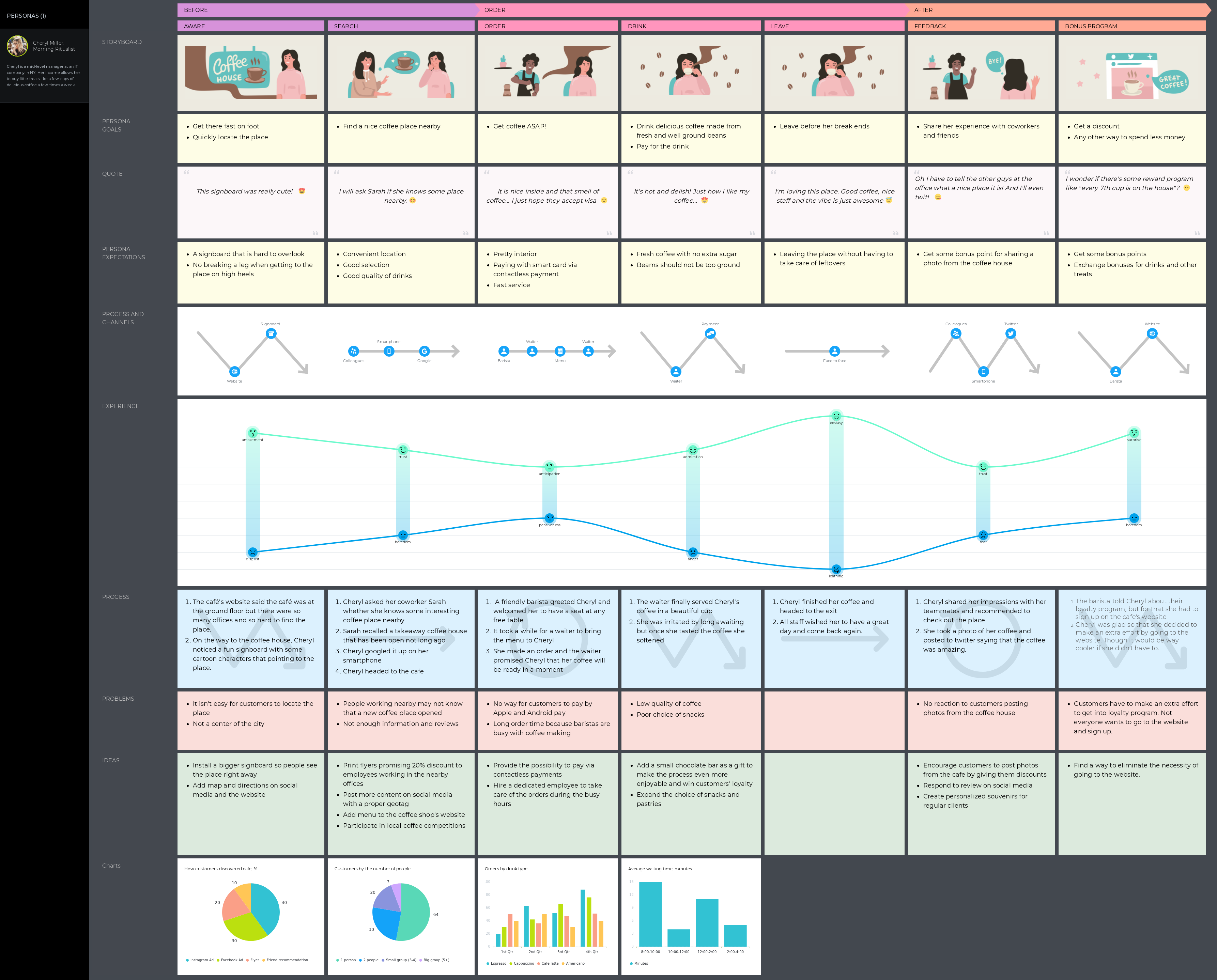
You can use this technique to understand how your business performs from your customers’ standpoint, as it allows you to put together all the data and order it in a clear and comprehensive way.
Some of the things you can do with the help of customer journey maps in e-commerce are:
- Capturing all the touchpoints and channels customers go through when visiting your e-commerce website. And what’s most important, understand what happens during those interactions;
- Understanding how customers feel at every step of their journey with you and what you can improve so they get less dissatisfied and more happy with your service;
- Indicating the pain points of the journey and brainstorming solutions;
- Discovering moments of truth for your customer.
Now that we’ve covered the basics, let’s proceed to a customer journey in e-commerce.
What is the e-commerce customer journey?
In e-commerce, a customer journey is a dynamic and evolving story shaped by individuals' interactions and experiences during their online shopping endeavors. At its core, it embodies the seamless fusion of technology, user expectations, and brand engagement.
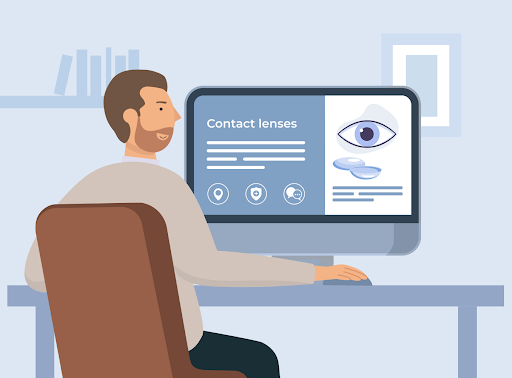
This narrative extends beyond the mere act of making a purchase, encompassing every touchpoint from the first spark of awareness to the post-purchase engagement.
In this intricate journey, the significance lies not just in the transaction itself but in the holistic experience crafted by businesses. A successful e-commerce user journey is characterized by personalized interactions, user-friendly interfaces, and the ability to anticipate and cater to customers' needs.
The journey becomes a testament to a brand's commitment to customer satisfaction, weaving together elements of convenience, trust, and delight, resulting in loyal and returning customers.
Understanding and optimizing the e-commerce customer journey is pivotal for businesses seeking to forge lasting connections with their clientele. It is a strategic approach that goes beyond the transactional aspect, acknowledging that each customer journey phase influences the brand's overall perception.
A positive journey fosters customer loyalty, encourages repeat business, and can transform satisfied customers into advocates who willingly share their positive experiences with others.
An e-commerce customer journey is also a valuable source of insights for businesses aiming to refine their strategies. By analyzing customer behavior, preferences, and pain points along the customer journey, companies can adapt and enhance their offerings continually. This iterative process ensures a competitive edge in the market and positions the brand as one that prioritizes and evolves with its customers.
Ultimately, the e-commerce customer journey is a narrative of reciprocity — a continuous exchange between the customer and the business. When thoughtfully navigated and enriched, it becomes a powerful tool for businesses to drive sales and establish enduring relationships in the digital marketplace.
The prep-work before the actual e-commerce journey mapping

To take the most out of your customer journey mapping process, you will need to make some preparations beforehand. Make sure you’ve got all the following things covered before starting with journey mapping.
Set the goal
Start with setting clear and achievable goals before getting down to the mapping part. Here are some examples of the goals you might want to target for your e-commerce project:
- increasing conversion and overall sales of an online store;
- discovering pain points and problems in a given scope of the journey;
- brainstorming the solutions for discovered problems;
- reduce the number of refunds;
- increase the number of reviews.
You can pick one or a combination of them. The bottom line here is you need a goal so it both helps you track progress and define the scope of the journey area you want to map.
Define the scope
Set the scope of the journey you’re going to map out. Covering the entire customer journey in e-commerce will take too much time and effort. Most likely, it won't be feasible to complete such a challenging task in a single sitting.
Instead, you can either start off with the most problematic part that needs immediate attention or focus on the part of the journey you already know too well. This way, you will be able to start mapping without investing in additional research.
Consider starting your mapping exercise with the stages related to one of the crucial elements of an e-commerce website — checkout. Although it’s not the first thing customers face when purchasing online, according to the statistics, around 70% of products added to the cart eventually get abandoned.
This is a powerful argument for taking checkout-related stuff more seriously and analyzing how to improve the customer experience at that particular stage of their journey.
Use personas
If you think mapping out your website page by page is enough, think again. You need to map a customer journey with your customer in mind, differentiating between customer and business goals. That’s where personas come into play.
Speaking scientifically(ish), a buyer persona is a collective image of a particular group of customers that represents their behavioral patterns, goals, expectations, and frustrations.
Creating a journey map without knowing exactly who your customers are is like creating a map for everyone and no one at the same time.
When mapping journeys for an online store , you will find that some buyer personas are more tech-savvy, and some are less. They will also have different goals when interacting with your site, expectations at journey stages, and experiences. As a result, their customer journeys will also differ.
Take all of that into account before you start mapping the journey of a particular customer segment.
Take a look at this buyer persona that we created for an e-commerce customer journey map example in our persona building tool :

Collect the data
Research is an essential step that comes before analyzing the customer journey of an online store. Adding real-world data brings tangibility to your journey maps and helps you identify the most problematic stages of the journey.
For instance, you will need to know how many visitors made it to the checkout page, how many eventually completed the purchase, becoming new customers, and the percentage of those who dropped out. If you have a multipage checkout, it would be useful to know which product pages cause your visitors to abandon their cart.
Web analytics is an excellent source of data. And by the way, you can combine that data with journey maps using our customer journey mapping tool . It supports the integration with Mixpanel and Google Analytics , which will let you display real-time analytics data on your e-commerce customer journey maps in the form of a marketing funnel.
That way, you will have some hard data to back up your journey maps.

Here are other data sources that can be used to learn about your customer journey before putting it on the map:
- HotJar uses interactive heatmaps of customer clicks and actions to help you visualize how they engage with particular online store pages and where they need help.
- Net Promoter Score (NPS) ranges from 0 to 10 and shows the willingness of your customer to recommend your product to others. This provides a simplified, yet highly effective vision of a brand’s popularity and customer loyalty .
- Teammates who can share knowledge about the actual customer journey and its particular stages. For example, if you decided to focus on improving the delivery stage, it would be reasonable to invite the stakeholders from the delivery department, from the head of the department to couriers who deal face-to-face with your customers.
E-commerce customer journey stages
What are typical e-commerce customer journey stages? We’ll explore them through a fictional example.
Imagine Sarah, an avid fitness enthusiast, scrolling through her social media feed. As she leisurely swipes through photos of scenic landscapes and adorable pets, she stumbles upon an eye-catching sponsored post showcasing a new line of high-performance activewear. It serves as the trigger, sparking the first phase of her e-commerce user journey: Awareness .
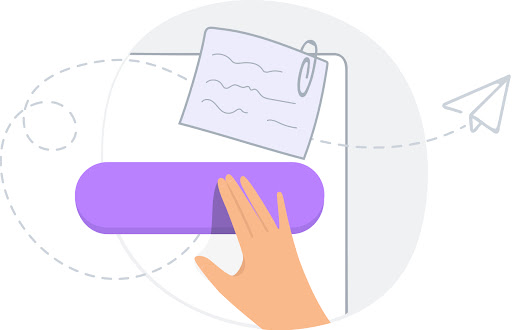
Intrigued, Sarah clicks on the post, delving into the brand's profile. She explores product images, reads captions, and clicks on a link leading her to the brand's website. Now, at the Interest stage, Sarah is on a quest for more information. She navigates through the site, exploring product descriptions and customer reviews, and perhaps watching a video highlighting the durability and style of the activewear.
The brand cleverly captures her interest, offering a 10% discount for first-time customers. Tempted by the offer and convinced by positive reviews, Sarah adds a few items to her virtual shopping cart. Now, she's transitioning to the Consideration stage, weighing the pros and cons of her selections.
As Sarah contemplates her choices, the brand doesn't let her enthusiasm wane. An automated email promptly lands in her inbox, acknowledging her cart activity and offering personalized recommendations based on her preferences. This thoughtful touch moves Sarah into the Decision-making stage, subtly nudging her closer to making a purchase decision.
Encouraged by the seamless online experience and the brand's customer-centric approach, Sarah confidently clicks the "Checkout" button. The purchase is complete, marking the Conversion stage. The brand doesn't stop there — they send a thank-you email, including a discount code for her next purchase and inviting her to join their loyalty program.
Sarah is now at the post-purchase, Delivery , stage. She eagerly awaits the delivery of her activewear, and the brand, through strategically timed follow-up emails, keeps her engaged by sharing fitness tips, styling ideas, and sneak peeks of upcoming collections. This not only ensures customer retention but also plants the seeds for Sarah's potential advocacy as a satisfied customer.
In this narrative, we've traced Sarah's e-commerce customer journey from awareness to post-purchase engagement, highlighting the importance of a seamless, personalized, and customer-centric experience throughout each step.
Let's now work together to create an e-commerce customer journey map example.
Creating an e-commerce customer journey map
It’s time to get down to actual mapping. First, you will need to draft the backbone (or skeleton) of the customer journey map. These are the stages a customer persona goes through while interacting with your online store.
Draft the backbone
Let’s continue with our delivery e-commerce customer journey map example and try to identify the substages of the delivery stage.
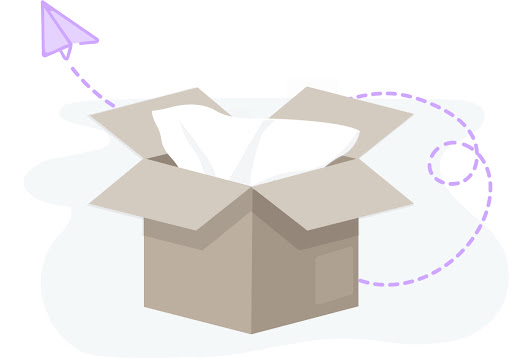
- Requesting the delivery. At this substage, customers complete the purchase and type in their delivery information. Usually, it is done at the checkout page, so it may be considered a major customer touchpoint to pay attention to at this substage.
- Confirmation call or email. Possible touchpoints of the substage: getting a confirmation email and communicating with a customer service agent.
- Waiting for the delivery. This might be the most irritating part of the delivery journey stage for many customers, so it’s a good idea to keep them updated on the delivery information while the item is on its way. Touchpoints may be the same as at the previous substage. Others could include, for example, getting email updates on the delivery status.
- Receiving the items. Contrary to the previous substage, it is the most joyful moment of the whole shopping process, so take your time to think about making it even more memorable. Touchpoints: courier, package.
- Signing the docs. Although this formality is kind of irrelevant for a customer at this point, make sure not to make it too complicated. Touchpoints: meeting a courier, signing delivery documentation.
Here is what the backbone of the e-commerce customer journey map will look like.
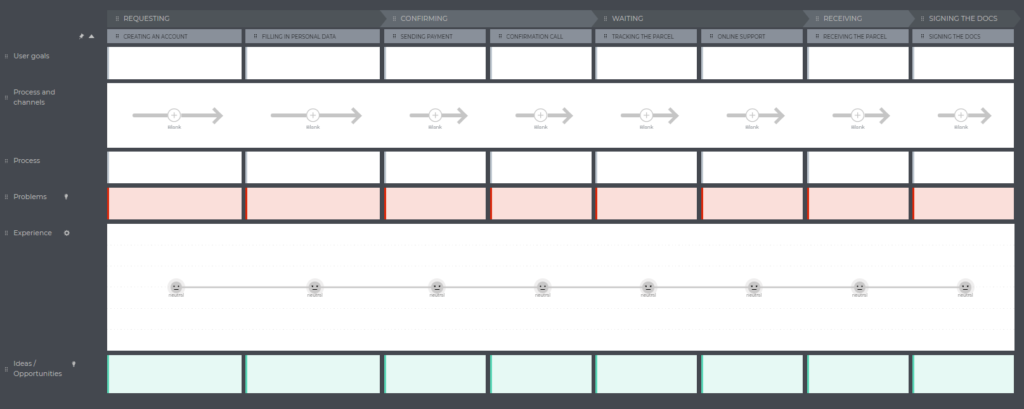
In the same way, you can divide the purchasing process into “Review cart”, “Checkout”, “Payment”, and other stages and analyze them in your map.
Add some meat
Let’s briefly look at other steps of creating a customer journey map.
- Customer goals and expectations
Adding customer goals and expectations will let everyone see what your customers pursue at each stage and how it aligns with the goals of your business. At the Search stage, this could be “finding the necessary product with minimum effort”; at the Waiting for the delivery substage, this is definitely “getting the product ASAP”, etc.
- Touchpoints
Identify the interactions happening between your business and customers at each stage: when visiting the homepage or the checkout page, during communication with the customer service agent, etc. This will help you determine the ones that need improvement and eliminate those that encourage your customers to move straight to your competitors.
- Processes & channels
Specify the channels the persona uses and what processes look like during their customer journey. Here are some channel examples: website, advertisement, social media, phone call, mobile app, email, etc. Make sure that the experience you deliver the same positive experience across all the channels.
- Problems & Ideas
Find the pain points the customer encounters while purchasing on your website. It can be a page that loads for years, poor website navigation, low-res images, slow and confusing checkout, lack of support, etc. After that, come up with ideas for solving these problems.
- Moments of truth
Moments of truth (MoTs) are the moments when a customer either stays with your business or leaves forever. For an e-commerce website, a site structure and design, the checkout page, communication with support, and the help center are the most common MoTs. So it's worth paying extra attention to such moments and ensuring everything about them is as customer-friendly as possible.
And that’s what you will see after you map out all these points and add some visual touch to your customer journey map:
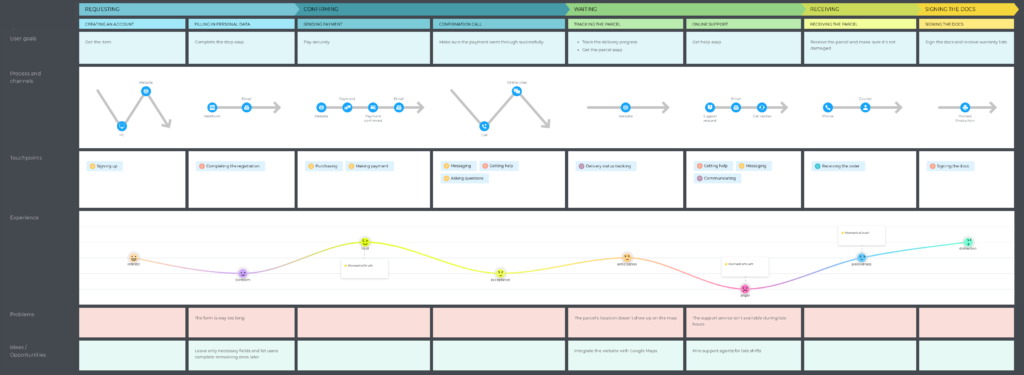
How online stores can improve their user journey?
With a finished map in front of you, you will be able to determine problems your customers have to deal with at different parts of the journey. And, certainly, you will start thinking about the ways to solve them.
Online stores can enhance their user journey through a combination of intuitive design, personalized customer experiences, and customer-centric strategies.
Below are some practical ways online stores can improve their user journey experience, illustrated with examples.
Streamlined navigation
Consider the ease with which customers can navigate through the website. Implement clear and intuitive menus, categorize products logically, and provide a search bar for quick access.
For instance, the online store of a well-known electronics brand organizes products by category and features a prominent search bar, allowing visitors to find what they need effortlessly.
Personalization
Leverage data to personalize your online shopping experience. An online clothing company, for instance, could use past purchase history to recommend complementary products or offer exclusive discounts based on customer preferences.
Amazon's personalized product recommendations serve as an excellent example of how tailored suggestions can enhance user engagement.
Mobile optimization
Recognize the prevalence of mobile users. Ensure the online store is optimized for various devices, particularly mobile phones. A fast, responsive, and mobile-friendly design enhances the overall customer experience. Launching a mobile app is also a bright idea.
The mobile app of a popular food delivery service is a prime example of seamless mobile optimization, allowing visitors to browse menus and place orders effortlessly on their smartphones.
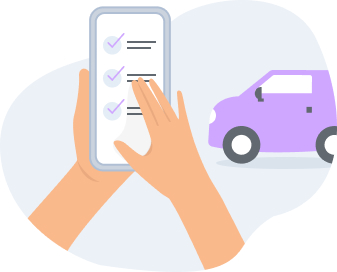
Transparent product information
Provide detailed product information, including specifications, sizing charts, and customer reviews. This transparency builds trust.
The online store of a cosmetics company, for instance, not only showcases product features but also includes video tutorials demonstrating the application of the products, enhancing the customer's understanding of what they look like on real people and confidence in their purchase.
Efficient checkout process
Simplify the checkout process to minimize friction.
A well-known online marketplace incorporates a one-click purchase option for registered users, reducing the steps required to complete a transaction. This streamlined approach saves time and reduces the likelihood of cart abandonment.
Some of the customers will also value a guest checkout option.
Responsive customer support team
Prioritize responsive and accessible customer support. Live chat features, chatbots, and clear contact information contribute to a positive user experience. And make sure to respond to your customer emails.
An online tech company, for instance, utilizes a chatbot for instant assistance, guiding users through common troubleshooting issues and product inquiries.
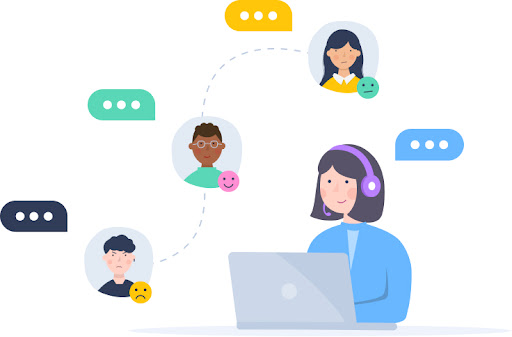
Post-purchase engagement
Continue engaging with customers at post-purchase stages. Send order confirmations, shipping updates, and request feedback.
An online bookstore, for example, sends personalized book recommendations based on a customer's purchase history, encouraging ongoing engagement and future purchases.
Social proof and trust signals
Incorporate social proof elements, such as customer testimonials, ratings, and trust badges into your website pages. A popular travel booking website prominently displays user reviews and satisfaction ratings, influencing potential customers' decisions and fostering trust in the platform.
By integrating these strategies and learning from successful examples, online stores can create a user journey experience that, besides being efficient and enjoyable, also establishes a strong connection between the business and its customers.
What to do next
Creating a CJM is a good chunk of work, but it doesn't end there. Maximize its value by articulating a clear plan for implementing ideas and passing it on to the responsible individuals.
Doing all that is so much easier with UXPressia as it allows collaboration with all the teammates simultaneously and has exporting and sharing capabilities.
In addition to that, we have created e-commerce customer journey map examples (and many more customer journey map examples) that already include some general stages and touchpoints.
SEE E-COMMERCE TEMPLATES
This is the updated article originally published in March 2019.
Rate this post
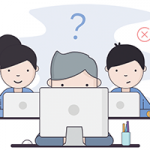
Hey Dan! Great article, can you please share with us high-quality pictures that we can read the details on the picture “complete customer journey map”? thanks!
Hey Netanel!
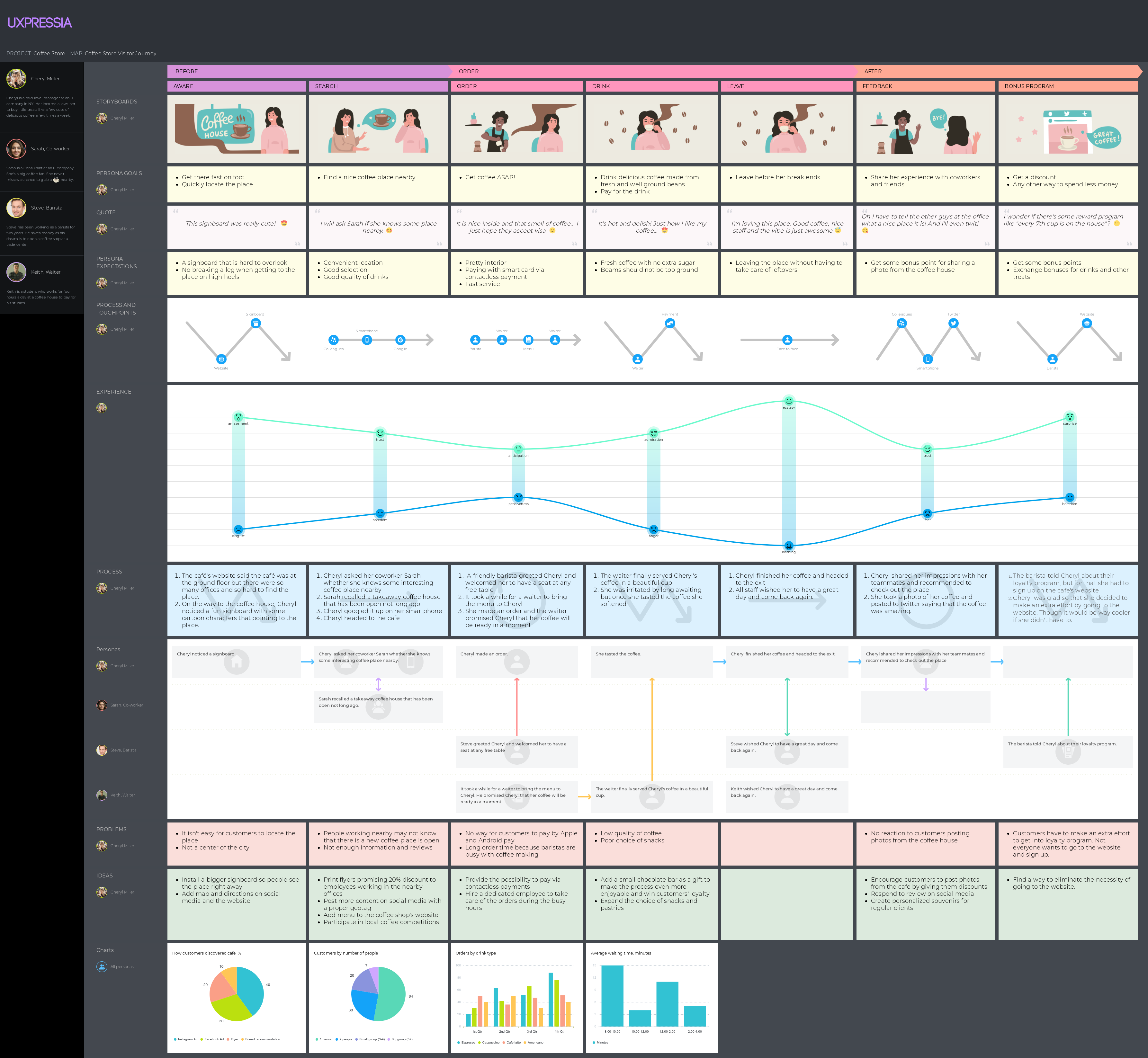
Adding analytics to a customer journey map in ecommerce is very powerful, great feature. It also means you have to regularly revisit and update the map with new data, which means you can track implementation progress and discover new areas for improvement. Thanks for the post
A nice customer journey ecommerce example, but I think what might be missing here is retention. We try to include it as the final stage for all our maps. At the very least, it helps us keep in mind that the ultimate goal is not only for the customer to have a good experience, but for them to actually come back to shop with us.
I couldn’t agree more! Creating a CJM is a vital step in the process of providing an exceptional user experience, but it’s equally important to have a clear plan for the implementation of the ideas generated from it. Also, thank you for the ecommerce customer journey map example. I’m gonna try and build my own map, using it as a reference. It’s always a headstart and offers a solid foundation. I’m looking forward to exploring UXPressia and leveraging its capabilities to create an outstanding CJM for our customers.
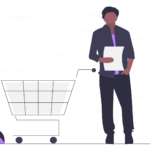
Customer Journey Maps: How to Create Really Good Ones [Examples + Template]
Updated: April 17, 2024
Published: May 04, 2023
Did you know 70% of online shoppers abandoned their carts in 2022? Why would someone spend time adding products to their cart just to fall off the customer journey map at the last second?

The thing is — understanding your customer base can be very challenging. Even when you think you’ve got a good read on them, the journey from awareness to purchase for each customer will always be unpredictable, at least to some level.

While it isn’t possible to predict every experience with 100% accuracy, customer journey mapping is a convenient tool for keeping track of critical milestones that every customer hits. In this post, I’ll explain everything you need to know about customer journey mapping — what it is, how to create one, and best practices.
Table of Contents
What is the customer journey?
What is a customer journey map, benefits of customer journey mapping, customer journey stages.
- What’s included in a customer journey map?
The Customer Journey Mapping Process
Steps for creating a customer journey map.
- Types of Customer Journey Maps
Customer Journey Mapping Best Practices
- Customer Journey Design
- Customer Journey Map Examples
Free Customer Journey Map Templates
.webp)
Free Customer Journey Template
Outline your company's customer journey and experience with these 7 free templates.
- Buyer's Journey Template
- Future State Template
- Day-in-the-Life Template
You're all set!
Click this link to access this resource at any time.
The customer journey is the series of interactions a customer has with a brand, product, or business as they become aware of a pain point and make a purchase decision. While the buyer’s journey refers to the general process of arriving at a purchase, the customer journey refers to a buyer's purchasing experience with a specific company or service.
Customer Journey vs. Buyer Journey
Many businesses that I’ve worked with were confused about the differences between the customer’s journey and the buyer’s journey. The buyer’s journey is the entire buying experience from pre-purchase to post-purchase. It covers the path from customer awareness to becoming a product or service user.
In other words, buyers don’t wake up and decide to buy on a whim. They go through a process of considering, evaluating, and purchasing a new product or service.
The customer journey refers to your brand’s place within the buyer’s journey. These are the customer touchpoints where you will meet your customers as they go through the stages of the buyer’s journey. When you create a customer journey map, you’re taking control of every touchpoint at every stage of the journey instead of leaving it up to chance.
For example, at HubSpot, our customer’s journey is divided into three stages — pre-purchase/sales, onboarding/migration, and normal use/renewal.

1. Use customer journey map templates.
Why make a customer journey map from scratch when you can use a template? Save yourself some time by downloading HubSpot’s free customer journey map templates .
This has templates that map out a buyer’s journey, a day in your customer’s life, lead nurturing, and more.
These templates can help sales, marketing, and customer support teams learn more about your company’s buyer persona. This will improve your product and customer experience.
2. Set clear objectives for the map.
Before you dive into your customer journey map, you need to ask yourself why you’re creating one in the first place.
What goals are you directing this map towards? Who is it for? What experience is it based upon?
If you don’t have one, I recommend creating a buyer persona . This persona is a fictitious customer with all the demographics and psychographics of your average customer. This persona reminds you to direct every aspect of your customer journey map toward the right audience.
3. Profile your personas and define their goals.
Next, you should conduct research. This is where it helps to have customer journey analytics ready.
Don’t have them? No worries. You can check out HubSpot’s Customer Journey Analytics tool to get started.
Questionnaires and user testing are great ways to obtain valuable customer feedback. The important thing is to only contact actual customers or prospects.
You want feedback from people interested in purchasing your products and services who have either interacted with your company or plan to do so.
Some examples of good questions to ask are:
- How did you hear about our company?
- What first attracted you to our website?
- What are the goals you want to achieve with our company? In other words, what problems are you trying to solve?
- How long have you/do you typically spend on our website?
- Have you ever made a purchase with us? If so, what was your deciding factor?
- Have you ever interacted with our website to make a purchase but decided not to? If so, what led you to this decision?
- On a scale of 1 to 10, how easily can you navigate our website?
- Did you ever require customer support? If so, how helpful was it, on a scale of 1 to 10?
- Can we further support you to make your process easier?
You can use this buyer persona tool to fill in the details you procure from customer feedback.
4. Highlight your target customer personas.
Once you’ve learned about the customer personas that interact with your business, I recommend narrowing your focus to one or two.
Remember, a customer journey map tracks the experience of a customer taking a particular path with your company. If you group too many personas into one journey, your map won’t accurately reflect that experience.
When creating your first map, it’s best to pick your most common customer persona and consider the route they would typically take when engaging with your business for the first time.
You can use a marketing dashboard to compare each and determine the best fit for your journey map. Don’t worry about the ones you leave out, as you can always go back and create a new map specific to those customer types.
5. List out all touchpoints.
Begin by listing the touchpoints on your website.
What is a touchpoint in a customer journey map?
A touchpoint in a customer journey map is an instance where your customer can form an opinion of your business. You can find touchpoints in places where your business comes in direct contact with a potential or existing customer.
For example, if I were to view a display ad, interact with an employee, reach a 404 error, or leave a Google review, all of those interactions would be considered a customer touchpoint.
Your brand exists beyond your website and marketing materials, so you must consider the different types of touchpoints in your customer journey map. These touchpoints can help uncover opportunities for improvement in the buying journey.
Based on your research, you should have a list of all the touchpoints your customers are currently using and the ones you believe they should be using if there’s no overlap.
This is essential in creating a customer journey map because it provides insight into your customers’ actions.
For instance, if they use fewer touchpoints than expected, does this mean they’re quickly getting turned away and leaving your site early? If they are using more than expected, does this mean your website is complicated and requires several steps to reach an end goal?
Whatever the case, understanding touchpoints help you understand the ease or difficulties of the customer journey.
Aside from your website, you must also look at how your customers might find you online. These channels might include:
- Social channels.
- Email marketing.
- Third-party review sites or mentions.
Run a quick Google search of your brand to see all the pages that mention you. Verify these by checking your Google Analytics to see where your traffic is coming from. Whittle your list down to those touchpoints that are the most common and will be most likely to see an action associated with it.
At HubSpot, we hosted workshops where employees from all over the company highlighted instances where our product, service, or brand impacted a customer. Those moments were recorded and logged as touchpoints. This showed us multiple areas of our customer journey where our communication was inconsistent.
The proof is in the pudding — you can see us literally mapping these touch points out with sticky notes in the image below.

Don't forget to share this post!
Related articles.
![customer journey map ecommerce example How AI Image Misuse Made a World of Miscommunication [Willy's Chocolate Experience]](https://blog.hubspot.com/hubfs/ai%20image%20misuse%20the%20willy%20wonka%20experience%20%281%29.png)
How AI Image Misuse Made a World of Miscommunication [Willy's Chocolate Experience]

7 Ways to Delight Your Customers This Holiday Season

14 Customer Experience Fails that Companies Can Learn From
![customer journey map ecommerce example How Customer Experience Has Evolved Over the Last Decade [+ 2024 Trends]](https://blog.hubspot.com/hubfs/future-of-customer-experience.png)
How Customer Experience Has Evolved Over the Last Decade [+ 2024 Trends]
![customer journey map ecommerce example Memorable Examples of AR in Customer Experience [+Tips for Implementing the Technology]](https://blog.hubspot.com/hubfs/augmented%20reality%20customer%20experience.png)
Memorable Examples of AR in Customer Experience [+Tips for Implementing the Technology]

Digital Customer Experience: The Ultimate Guide for 2023
![customer journey map ecommerce example How to Implement a Hybrid Customer Service Strategy That Works [Expert Tips]](https://blog.hubspot.com/hubfs/hybrid%20customer%20service_featured.png)
How to Implement a Hybrid Customer Service Strategy That Works [Expert Tips]

User Flows: 8 Tips For Creating A Super Smooth User Experience

11 Best Practices for B2B Customer Experience
![customer journey map ecommerce example Customer Experience vs. User Experience: What’s the Difference? [+ Examples]](https://blog.hubspot.com/hubfs/customer-experience-vs-user-experience_2.webp)
Customer Experience vs. User Experience: What’s the Difference? [+ Examples]
Outline your company's customer journey and experience with these 7 free customer journey map templates.
Service Hub provides everything you need to delight and retain customers while supporting the success of your whole front office
What is a Customer Journey Map? [Free Templates]
Learn what the customer journey mapping process is and download a free template that you can use to create your own customer journey map.

Table of Contents
Mapping the customer journey can give you a way to better understand your customers and their needs. As a tool, it allows you to visualize the different stages that a customer goes through when interacting with your business; their thoughts, feelings, and pain points.
And, it’s shown that the friction from those pain points costs big: in 2019, ecommerce friction totaled an estimated 213 billion in lost US revenue .
Customer journey maps can help you to identify any problems or areas where you could improve your customer experience . In this article, we’ll explain what the customer journey mapping process is and provide a free template that you can use to create your own map. Let’s get started!
Bonus: Get our free, fully customizable Customer Experience Strategy Template that will help you understand your customers and reach your business goals.
What is a customer journey map?
So, what is customer journey mapping? Essentially, customer journey maps are a tool that you can use to understand the customer experience. Customer journey maps are often visual representations showing you the customer’s journey from beginning to end. They include all the touchpoints along the way.
There are often four main stages in your sales funnel, and knowing these can help you create your customer journey maps:
- Inquiry or awareness
- Interest, comparison, or decision-making
- Purchase or preparation
- Installation, activation, or feedback
Customer journey maps are used to track customer behavior and pinpoint areas where the customer experiences pain points. With this information uncovered, you can improve the customer experience, giving your customers a positive experience with your company.
You can use customer journey mapping software like Excel or Google sheets, Google Decks, infographics, illustrations, or diagrams to create your maps. But you don’t actually need customer journey mapping tools. You can create these maps with a blank wall and a pack of sticky notes.
Though they can be scribbled on a sticky note, it’s often easier to create these journeys digitally. That way, you have a record of your journey map, and you can share it with colleagues. We’ve provided free customer journey mapping templates at the end of this article to make your life a little easier.
The benefits of using customer journey maps
The main benefit of customer journey mapping is a better understanding of how your customers feel and interact with your business touchpoints. With this knowledge, you can create strategies that better serve your customer at each touchpoint.
Give them what they want and make it easy to use, and they’ll keep coming back. But, there are a couple of other great knock-on benefits too.
Improved customer support
Your customer journey map will highlight moments where you can add some fun to a customer’s day. And it will also highlight the pain points of your customer’s experience. Knowing where these moments are will let you address them before your customer gets there. Then, watch your customer service metrics spike!
Effective marketing tactics
A greater understanding of who your customers are and what motivates them will help you to advertise to them.
Let’s say you sell a sleep aid product or service. A potential target market for your customer base is young, working mothers who are strapped for time.
The tone of your marketing material can empathize with their struggles, saying, “The last thing you need is someone asking if you’re tired. But we know that over half of working moms get less than 6 hours of sleep at night. While we can’t give you more time, we know how you can make the most of those 6 hours. Try our Sleep Aid today and sleep better tonight.”
Building out customer personas will show potential target audiences and their motivation, like working moms who want to make the most of their hours asleep.
Product advancements or service improvements
By mapping your customer’s journey, you’ll gain insights into what motivates them to make a purchase or prevents them from doing so. You’ll have clarity on when or why they return items and which items they buy next. With this information and more, you’ll be able to identify opportunities to upsell or cross-sell products.
A more enjoyable and efficient user experience
Customer journey mapping will show you where customers get stuck and bounce off your site. You can work your way through the map, fixing any friction points as you go. The end result will be a smoothly-running, logical website or app.
A customer-focused mindset
Instead of operating with the motivation of business success, a customer journey map can shift your focus to the customer. Instead of asking yourself, “how can I increase profits?” ask yourself, “what would better serve my customer?” The profits will come when you put your customer first.
At the end of the day, customer journey maps help you to improve your customer experience and boost sales. They’re a useful tool in your customer experience strategy .
How to create a customer journey map
There are many different ways to create a customer journey map. But, there are a few steps you’ll want to take regardless of how you go about mapping your customer’s journey.
Step 1. Set your focus
Are you looking to drive the adoption of a new product? Or perhaps you’ve noticed issues with your customer experience. Maybe you’re looking for new areas of opportunity for your business. Whatever it is, be sure to set your goals before you begin mapping the customer journey.
Step 2. Choose your buyer personas
To create a customer journey map, you’ll first need to identify your customers and understand their needs. To do this, you will want to access your buyer personas.
Buyer personas are caricatures or representations of someone who represents your target audience. These personas are created from real-world data and strategic goals.
If you don’t already have them, create your own buyer personas with our easy step-by-step guide and free template.
Choose one or two of your personas to be the focus of your customer journey map. You can always go back and create maps for your remaining personas.
Step 3. Perform user research
Interview prospective or past customers in your target market. You do not want to gamble your entire customer journey on assumptions you’ve made. Find out directly from the source what their pathways are like, where their pain points are, and what they love about your brand.
You can do this by sending out surveys, setting up interviews, and examining data from your business chatbot . Be sure to look at what the most frequently asked questions are. If you don’t have a FAQ chatbot like Heyday , that automates customer service and pulls data for you, you’re missing out!

Get a free Heyday demo
You will also want to speak with your sales team, your customer service team, and any other team member who may have insight into interacting with your customers.
Step 4. List customer touchpoints
Your next step is to track and list the customer’s interactions with the company, both online and offline.
A customer touchpoint means anywhere your customer interacts with your brand. This could be your social media posts , anywhere they might find themselves on your website, your brick-and-mortar store, ratings and reviews, or out-of-home advertising.
Write as many as you can down, then put on your customer shoes and go through the process yourself. Track the touchpoints, of course, but also write down how you felt at each juncture and why. This data will eventually serve as a guide for your map.
Step 5. Build your customer journey map
You’ve done your research and gathered as much information as possible, now it’s time for the fun stuff. Compile all of the information you’ve collected into one place. Then, start mapping out your customer journey! You can use the templates we’ve created below for an easy plug-and-play execution.
Step 6. Analyze your customer journey map
Once the customer journey has been mapped out, you will want to go through it yourself. You need to experience first-hand what your customers do to fully understand their experience.
As you journey through your sales funnel, look for ways to improve your customer experience. By analyzing your customer’s needs and pain points, you can see areas where they might bounce off your site or get frustrated with your app. Then, you can take action to improve it. List these out in your customer journey map as “Opportunities” and “Action plan items”.
Types of customer journey maps
There are many different types of customer journey maps. We’ll take you through four to get started: current state, future state, a day in the life, and empathy maps. We’ll break down each of them and explain what they can do for your business.
Current state
This customer journey map focuses on your business as it is today. With it, you will visualize the experience a customer has when attempting to accomplish their goal with your business or product. A current state customer journey uncovers and offers solutions for pain points.
Future state
This customer journey map focuses on how you want your business to be. This is an ideal future state. With it, you will visualize a customer’s best-case experience when attempting to accomplish their goal with your business or product.
Once you have your future state customer journey mapped out, you’ll be able to see where you want to go and how to get there.
Day-in-the-life
A day-in-the-life customer journey is a lot like the current state customer journey, but it aims to highlight aspects of a customer’s daily life outside of how they interact with your brand.
Day-in-the-life mapping looks at everything that the consumer does during their day. It shows what they think and feel within an area of focus with or without your company.
When you know how a consumer spends their day, you can more accurately strategize where your brand communication can meet them. Are they checking Instagram on their lunch break, feeling open and optimistic about finding new products? If so, you’ll want to target ads on that platform to them at that time.
Day-in-the-life customer journey examples can look vastly different depending on your target demographic.
Empathy maps
Empathy maps don’t follow a particular sequence of events along the user journey. Instead, these are divided into four sections and track what someone says about their experience with your product when it’s in use.
You should create empathy maps after user research and testing. You can think of them as an account of all that was observed during research or testing when you asked questions directly regarding how people feel while using products. Empathy maps can give you unexpected insights into your users’ needs and wants.
Customer journey map templates
Use these templates to inspire your own customer journey map creation.
Customer journey map template for the current state:

The future state customer journey mapping template:

A day-in-the-life customer journey map template:

An empathy map template:

A customer journey map example
It can be helpful to see customer journey mapping examples. To give you some perspective on what these look like executed, we’ve created a customer journey mapping example of the current state.

Buyer Persona:
Curious Colleen, a 32-year-old female, is in a double-income no-kids marriage. Colleen and her partner work for themselves; while they have research skills, they lack time. She is motivated by quality products and frustrated by having to sift through content to get the information she needs.
What are their key goals and needs? Colleen needs a new vacuum. Her key goal is to find one that will not break again.
What are their struggles?
She is frustrated that her old vacuum broke and that she has to spend time finding a new one. Colleen feels as though this problem occurred because the vacuum she bought previously was of poor quality.
What tasks do they have?
Colleen must research vacuums to find one that will not break. She must then purchase a vacuum and have it delivered to her house.
Opportunities:
Colleen wants to understand quickly and immediately the benefits our product offers; how can we make this easier? Colleen upholds social proof as a decision-making factor. How can we better show our happy customers? There is an opportunity here to restructure our website information hierarchy or implement customer service tools to give Colleen the information she needs faster. We can create comparison charts with competitors, have benefits immediately and clearly stated, and create social campaigns.
Action Plan:
- Implement a chatbot so customers like Colleen can get the answers they want quickly and easily.
- Create a comparison tool for competitors and us, showing benefits and costs.
- Implement benefit-forward statements on all landing pages.
- Create a social campaign dedicated to UGC to foster social proof.
- Send out surveys dedicated to gathering customer feedback. Pull out testimonial quotes from here when possible.
Now that you know what the customer journey mapping process is, you can take these tactics and apply them to your own business strategy. By tracking customer behavior and pinpointing areas where your customers experience pain points, you’ll be able to alleviate stress for customers and your team in no time.
Turn customer conversations and inquiries into sales with Heyday, our dedicated conversational AI chatbot for social commerce retailers. Deliver 5-star customer experiences — at scale.
Turn customer service conversations into sales with Heyday . Improve response times and sell more products. See it in action.

Become a better social marketer.
Get expert social media advice delivered straight to your inbox.
Colleen Christison is a freelance copywriter, copy editor, and brand communications specialist. She spent the first six years of her career in award-winning agencies like Major Tom, writing for social media and websites and developing branding campaigns. Following her agency career, Colleen built her own writing practice, working with brands like Mission Hill Winery, The Prevail Project, and AntiSocial Media.
Related Articles

FAQ Chatbot: The Best Way to Save Time on Customer Service
FAQ chatbots are bots designed to answer common questions people have about a product or service. They are used on websites or in customer service applications.

Customer Service Metrics: 2024 Guide + Free Template
Customers expect to get support wherever they look for and they expect it fast. To keep up, track the customer service metrics that matter.

Create a Customer Experience Strategy [FREE TEMPLATE]
This step-by-step template makes it easy to deliver a well-laid-out customer experience strategy that can give you planned, targeted growth.

Customer Experience Management Explained [11 Top Tips]
Turn that frown upside down! Keep your customers smiling with a strong customer experience management strategy.

Learn / Guides / Customer journey mapping (CJM) guide
Back to guides
How 5 businesses successfully mapped out the customer journey
Creating a customer journey map puts you in your customers’ shoes to help you understand the user experience—what your users think, feel, and do at each stage of their buying journey.
Last updated
Reading time.
We’ve put together a list of five brilliant customer journey mapping (CJM) examples to show you how it’s done, so you can learn how to improve the user experience (UX) for your customers.
Want to know how customers really interact with your product?
Hotjar’s product experience insights tools let you see things through their eyes.
5 great examples of customer journey mapping
A good customer journey map identifies buyers’ actions, desires, and experiences at every key touchpoint—from when a customer lands on your webpage all the way to conversion, onboarding, and beyond.
Our list of customer journey examples breaks down the best B2B, B2C, ecommerce, and SaaS journey maps—and shows you how to understand your customers better to build your own.
1. Hotjar’s B2B customer journey map
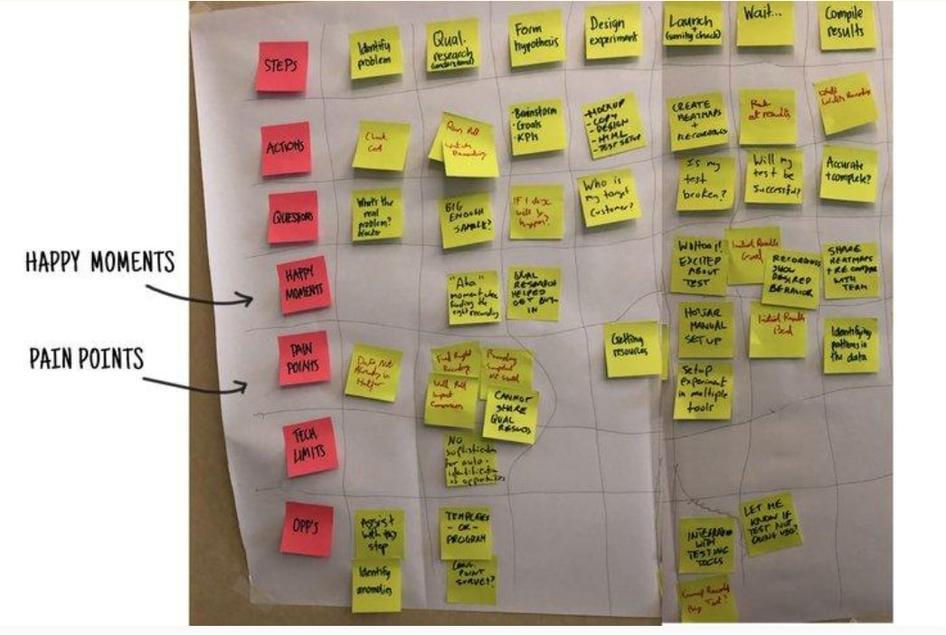
At Hotjar (👋), we make product experience (PX) insights tools to help businesses understand how their customers interact with their websites and digital products. And, of course, we’ve done some B2B customer journey mapping of our own to understand what our customers want, by tracking their interactions across key touchpoints.
The result was the digital customer journey example shown above that maps our customers' experience when they use Hotjar tools for product testing. We visualized the key actions, questions, technical limitations, and opportunities of customers using our tools to get granular data to validate our product ideas and experiments.
We started by identifying one specific customer journey, then used Google Analytics, Hotjar tools, and data from customer interactions with our brand to understand user actions, thoughts, and feelings. Then, we got UX, dev, engineering, and customer success teams to fill out empathy maps before mapping the journey.
To increase empathy with our customers, we included two rows dedicated to pain points and happy moments—like the pain of finding patterns in complex customer data, and the ‘a-ha moment' when our users first realize value.
We made our map flexible enough to be updated as customer needs change and new information becomes available, so we continually validate our assumptions against customers’ real-world experiences.
The benefits of customer journey mapping included helping us visualize customer motivations, drivers, and pain points, align cross-functional teams , eliminate silos, and clarify who owns each part of the buyer journey.
How B2B companies selling self-serve digital products can create a similar map:
1. Define the goal and scope of your customer journey map. We recommend starting with a narrow scope and only a few people involved. Focus on a specific problem you can break down into a few steps—like identifying where you’re losing users, and mapping out the pains, desires, and experiences of customers who exit your site.
Ask yourself:
What do you want to achieve?
Which customer journey touchpoints do you want to focus on?
What KPIs do you want to measure?
Where can you get the data you need?
Which teams need to be involved?
2. Use Google Analytics and Hotjar's Observe tools to collect user insights about online interactions:
Create Hotjar Heatmaps on key product pages to see where users are clicking and which parts of your page aren’t engaging users or working as intended. Then, improve UX and optimize the placement of on-page elements to boost conversions.
Use Session Recordings to see how users scroll, click, and move around your site across an entire session. Focus on spotting bugs and blockers that cause them to bounce.
3. Add qualitative user data from service chat logs, emails, or by asking customer support teams.
4. Get key product and customer service teams to fill in an empathy map detailing what your buyers do, say, see, hear, think, and feel. Feel free to steal our free template below!
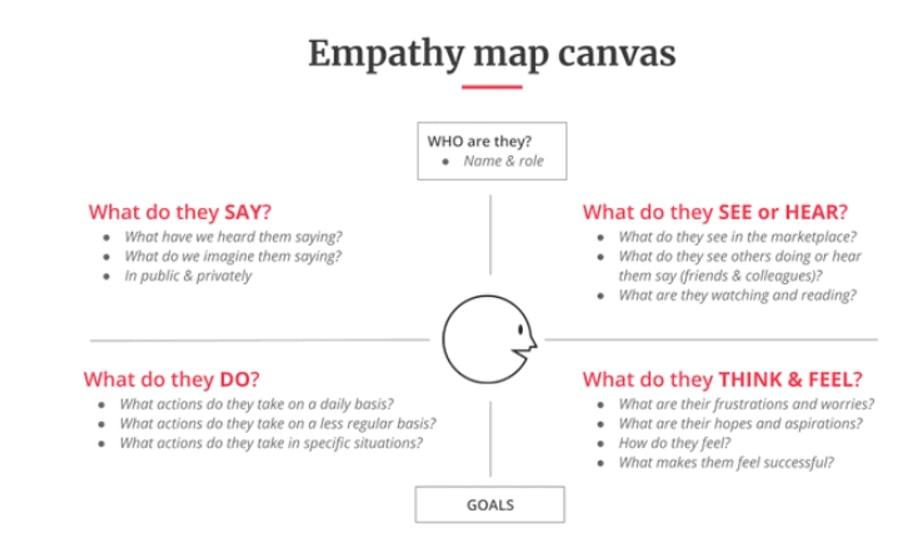
5. Map the journey with Post-its and pens before digitizing it and sharing it across the company.
2. Rail Europe’s B2C journey map
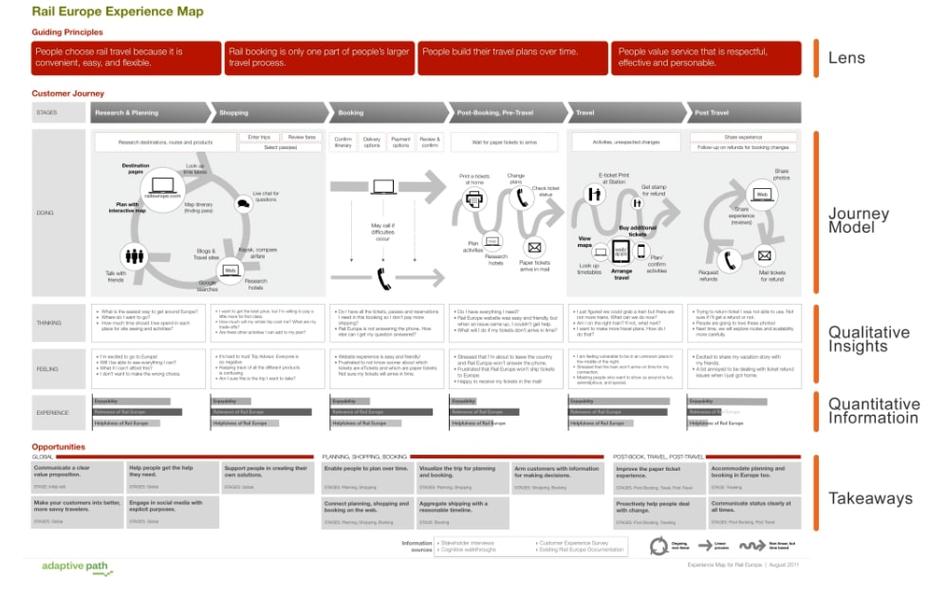
B2C ecommerce travel provider Rail Europe gives customers an easy way to book rail tickets online. Their on-site user interface (UI) is strong, but the company wanted to go deeper to understand the customer journey across all touchpoints.
Mapping the customer journey produced a full spectrum customer experience map that illustrates the buyer's journey before, during, and after a purchase. It reminded their team that the buyer journey starts long before a customer lands on the website to book a ticket—and continues after the trip, through touchpoints like post-trip refunds, sharing recommendations, or publishing photos on social media.
Rail Europe’s customer journey map also shows the transition between stages or channels to accurately visualize what is often a non-linear journey . For example, in the initial research, planning, and shopping phases, customers often move back and forth between comparison pages, checking timetables, and website chat and planning features.
Mapping the journey like this helps Rail Europe understand different customers’ channel preferences, see which touchpoints aren’t working as they should, and which aspects of the user experience need more attention from design teams, marketing, and customer support. They visualized actions, thoughts, feelings, and experiences and rated the customer satisfaction of each stage, as well as the relevance and helpfulness of Rail Europe, to home in on areas for improvement.
The map doubles down on customer empathy by identifying travelers’ overall concerns and frustrations while on the trip, even those unrelated to their rail journey—the overall travel experience is still connected with the company brand in customers’ minds.
This stand-alone map can be understood across teams without supporting materials, and there’s a focus on actionable insights—like the need to address customer frustrations over snail mail ticket delivery.
Ecommerce website analysis like this is valuable for any company selling experiential products or services, like concert tickets, vacations, or tours. If that’s you, follow Rail Europe’s example and conduct customer journey map research by surveying current and potential customers to uncover exactly what they’re hoping for, thinking, and feeling as they engage with your brand.
Tips to map out the ecommerce customer journey:
1. Ask yourself:
How can we access users who aren’t yet customers?
What happens before the customer gets to our web page? How do they do research for a trip? What kinds of search keywords do they use online?
Is the buyer journey non-linear? If not, how can we represent this?
2. If your buyer journey has multiple touchpoints, group them into categories like 'research and planning', 'shopping', 'booking', etc.
3. Match survey insights to touchpoints and map out the journey visually, adding qualitative insights about what the customer is thinking, feeling, and doing at each stage.
💡 Pro tip: use Hotjar Surveys to collect real-time suggestions about your website or app from users to make data-driven decisions and validate assumptions that inform and elevate your customer journey map.
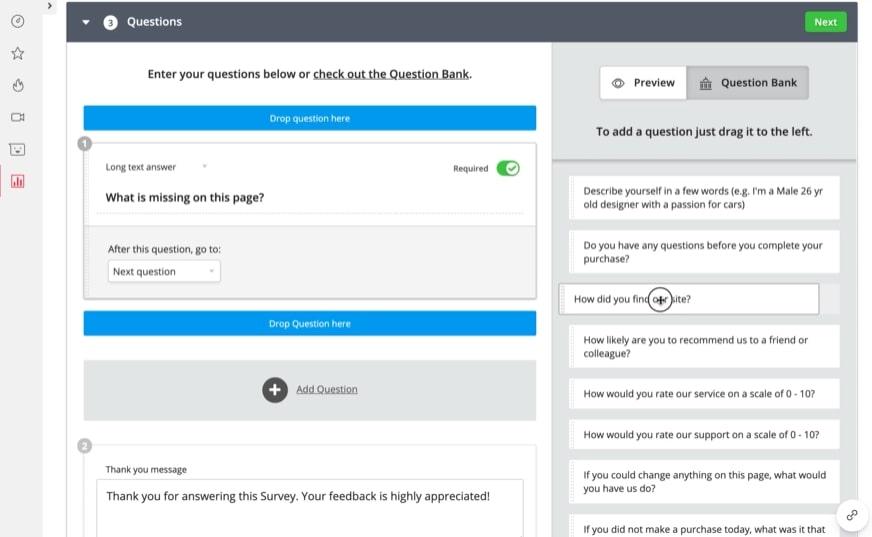
Hotjar’s no-code UI makes it easy to create drag-and-drop surveys
3. Rewind’s SaaS customer journey map
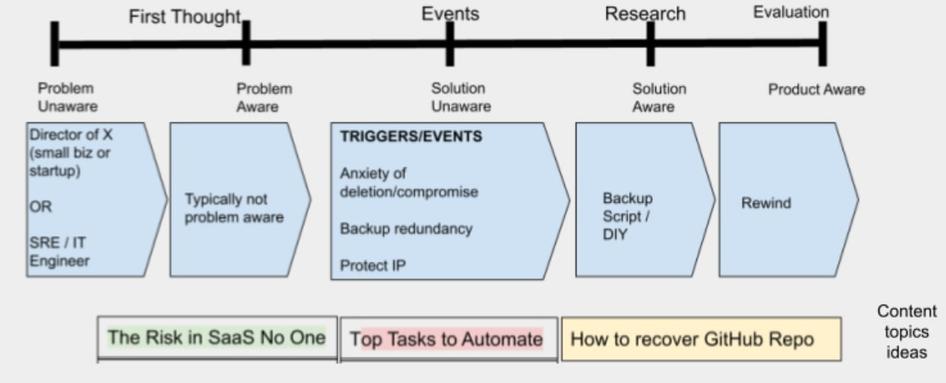
Rewind makes backup & restoration software for SaaS platforms. Their team decided to map out the B2B SaaS customer journey when revenue fell short of expectations after the acquisition of a similar product. It also became clear that marketing efforts weren’t attracting the ideal customer.
Like many SaaS companies, Rewind relied on sales calls and customer relationship management (CRM) data to understand their users. But they were missing key insights about what happens before the customer lands on their website.
To map the journey, the Rewind team defined their ideal customer profile (ICP) before conducting customer interviews to deeply understand buyer motivations and the decision-making process. They also used Google Analytics, Hubspot , and PX insights tools to understand users’ online behavior and how they were interacting with marketing materials.
This showed them a short, high-intent, back-and-forth customer journey that happens almost exclusively online—since Rewind is installed in SaaS platforms, a lot of traffic is referred from their app marketplaces.
The map showed event triggers and the customer’s thoughts and feelings as they moved through becoming aware of their problem (loss of important data), understanding the need for a solution, and doing online research—before arriving at Rewind.
By mapping the full journey, the Rewind team discovered that customers often use professional forums or communities as part of solution research, and discovered a new buyer motivation and market segment: data compliance.
According to Content Lift Founder Ryan Paul Gibson , who helped Rewind conduct customer interviews, the company also realized “potential buyers don’t want to speak with sales or ‘get a demo'. They want to research the product themselves and evaluate it. They also don’t want to enter a credit card to test it; they want to try it first and pay if it’s a good fit.”
Rewind updated their go-to-market strategy, personas, product positioning , and marketing to complete these missing steps in the customer journey map.
The result? A two-fold increase in product installations, and better internal alignment on their ICP—which has improved their efficiency and helped them maximize resources.
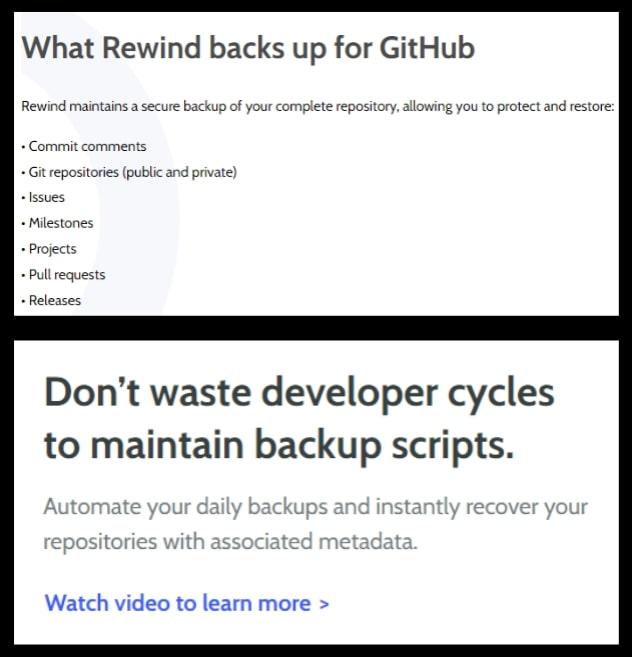
To create a great SaaS customer journey map:
Set your research objectives
Create a list of topics that align with your ideal buyer journey. For example, in Rewind’s case, they were customers’ reasons for buying, details about their company and role, and what caused them to start searching for a solution.
Create questions to ask customers during interviews, but leave flexibility for discussion.
Run in-depth customer interviews to capture the exact order of events in the buyer journey and make sure you understand every customer action and touchpoint—from users identifying a problem to making a purchase.
Bucket interview insights into user priorities, pains, and anxieties—what happened to trigger a search; which research channels the customer uses; how they evaluate solutions.
4. Spotify’s B2C customer journey map
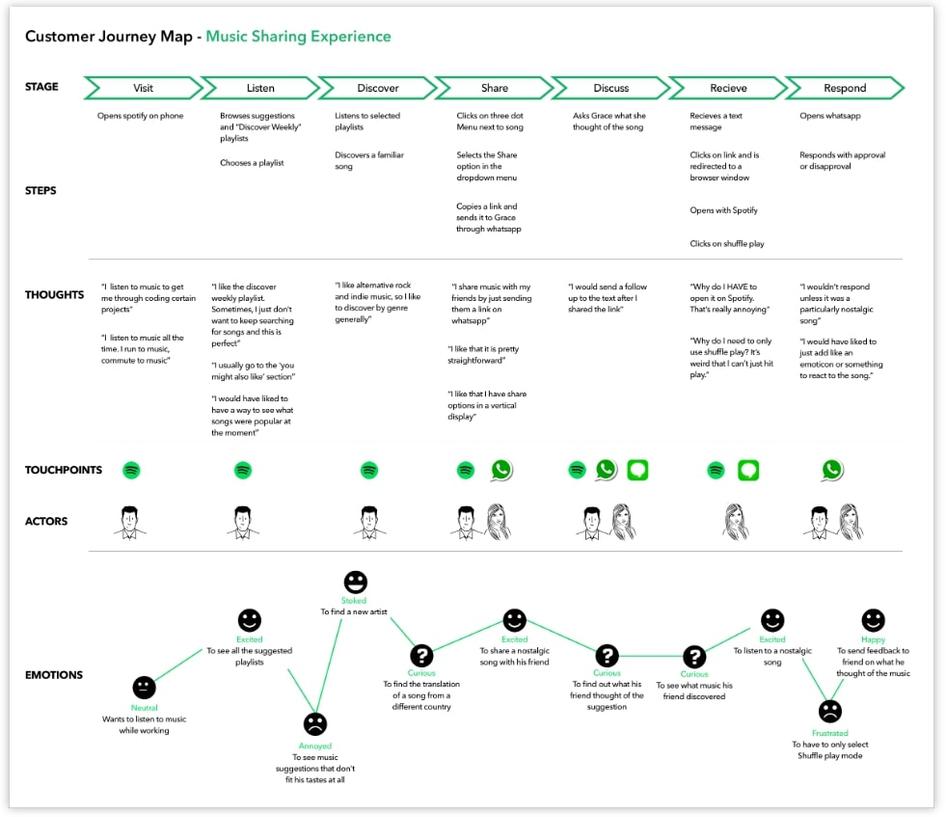
When music streaming app Spotify mapped the user journey, their team focused on tracking touchpoints for one specific feature: sharing playlists via third-party apps.
Their map zeroes in on clearly defined user personas and identifies key areas of customer engagement with a focus on users’ emotions and thoughts at each stage.
The team’s journey mapping research revealed a key customer pain point—fear of being judged for their music taste—that can hold users back from sharing music. They also identified an awareness gap to address: some users didn’t know the feature existed.
By mapping the user journey, Spotify improved their UI and in-app flows to streamline the customer experience and make every touchpoint relevant to how real customers use the product.
Mapping user flows is key for digital B2C brands with a product that lives and dies by good usability—and a business model that relies on customer loyalty.
To map the user journey before improving or launching a feature:
Conduct market research based on direct and indirect competitors to understand how people use similar features, and what they expect from yours.
In user interviews , focus on the specific feature or stage of the journey. Why aren’t customers using it as you’d like? What are the barriers to product adoption? Dig deep into what motivates users to complete a specific action—and what blocks them.
Using interview data, create a buyer persona and include their key needs and motivations. What can you do to bring this feature to their attention and boost adoption?
Create a customer journey map combining stages in the user’s interaction with the feature, and break down the actions they take and the thoughts and emotions they have at each stage.
Use these insights to remove friction and improve user flows, validating your design with real users.
Pro tip : use Hotjar's Observe tools to study Session Recordings and Heatmaps and get insights into the product experience of real or test users at every point in the customer journey.
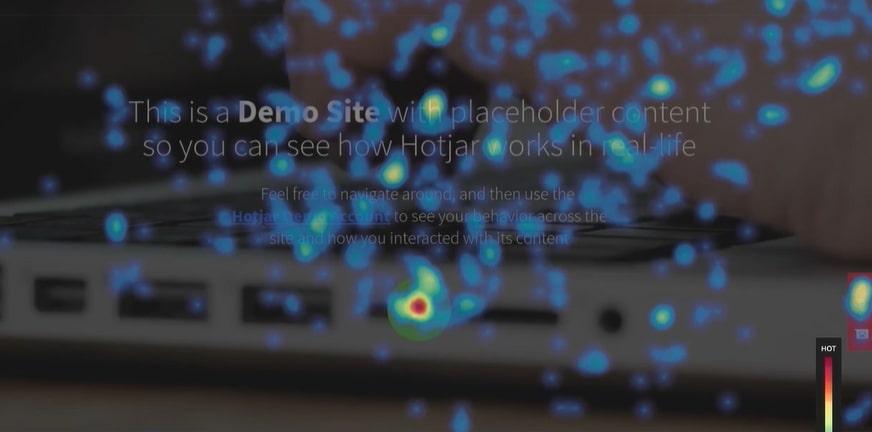
Heatmaps show you an intuitive aggregated view of which parts of your site are attracting attention and which aren’t to help you make changes that improve UX
5. Emirates Airline’s multi-channel customer journey map
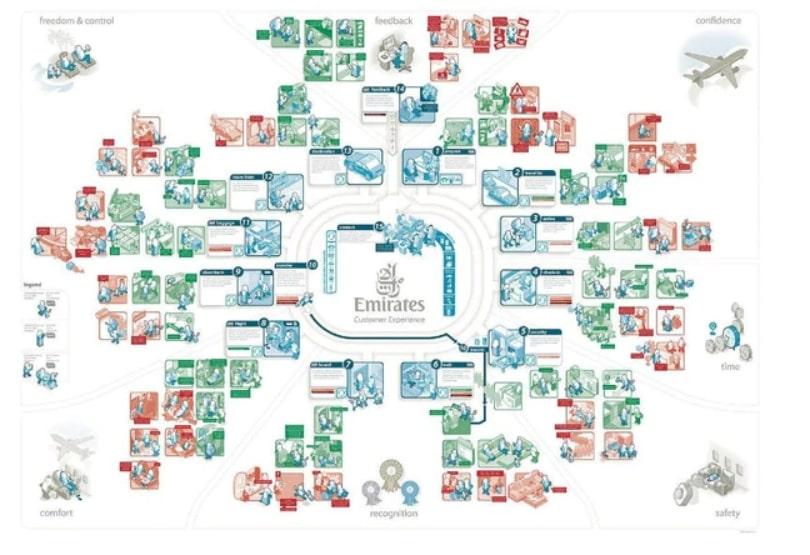
To reflect their customers’ multi-channel journey, flag carrier Emirates created a CJM that covers reservations, check-in, and onboarding experiences.
As well as digital channels, the map includes call center interactions, which provide context for interactive voice response (IRV) technology and human service agents. It also sheds light on customer desires, broken down into categories like ‘comfort’, ‘safety’, ‘confidence’, and ‘freedom & control’, shown in the corners of the map.
With a global brand like Emirates, customers expect the same experience at all touchpoints, in all countries. This exercise helped the Emirates team understand customers’ main interactions and expectations to better coordinate service touchpoints and provide a consistent, high-quality experience across each one.
For example, they set up a single, virtual contact center platform to increase efficiency and ensure consistent interactions across every channel. It’s not just the customer who benefits: the Emirates team now better understands exactly how to meet user needs across several channels and countries.
This map is ideal for businesses whose customer journey combines online and offline touchpoints, especially companies looking to differentiate themselves through the quality of their service.
How to implement a multi-channel customer journey map:
Define your key goals for producing the map.
Conduct thorough market research and customer interviews to reduce your assumptions and understand every single interaction and channel customers experience.
Interview customer experience and support staff members at all touchpoints and in all regions.
Use analytics tools and product experience insights software to understand how buyers interact with your digital marketing, website, and chat functions across channels and locations.
Use AI to analyze customer call recordings for tone and sentiment.
Pro tip: use Hotjar Feedback widgets to get in-context insights about what users really think about your app or website. You can filter feedback by region or channel to better understand your global customer touchpoints.
Hotjar's non-invasive Feedback widgets allow customers to give their opinions of your website or product as they experience it.
You’ve reached your destination: a truly valuable customer journey map
Customers interact with your brand over a variety of channels and touchpoints, and their journeys aren’t always linear. But understanding their journey is key to improving your product and boosting customer acquisition, adoption, and retention.
Follow these customer journey mapping examples to experience key touchpoints from your users’ point of view and grasp their pains, needs, and frustrations so you can build a journey your customers will love.
Want to know how customers really interact with your brand?
Frequently asked questions about customer journey mapping, what are the stages of the customer's journey.
Buyer journeys can typically be broken down into three steps or stages:
Awareness of a problem or pain
Consideration (researching and evaluating solutions)
Making a decision
What does a strong customer journey map look like?
A good customer journey map includes all the touchpoints where a customer interacts with your brand. It should include the various stages of the marketing and sales cycle, customer touchpoints across your product and website, and map out customers’ actions, thoughts, and feelings at each stage, as well as KPIs.
For example, Rail Europe’s customer journey map tracks all the stages of research, planning, and shopping, through to booking, travel, and post-travel. At each stage, it maps out customer questions, concerns, and feelings, as well as the helpfulness and relevance of Rail Europe.
What are the stages of customer journey mapping?
Customer journey map stages are:
Collecting data and conducting customer interviews or surveys
Mapping the customer journey in a workshop
Extracting insights and producing a report
CJM tools: features and how to choose
Previous chapter
CJM research
Next chapter
How to Make Sense of the Ecommerce Customer Journey
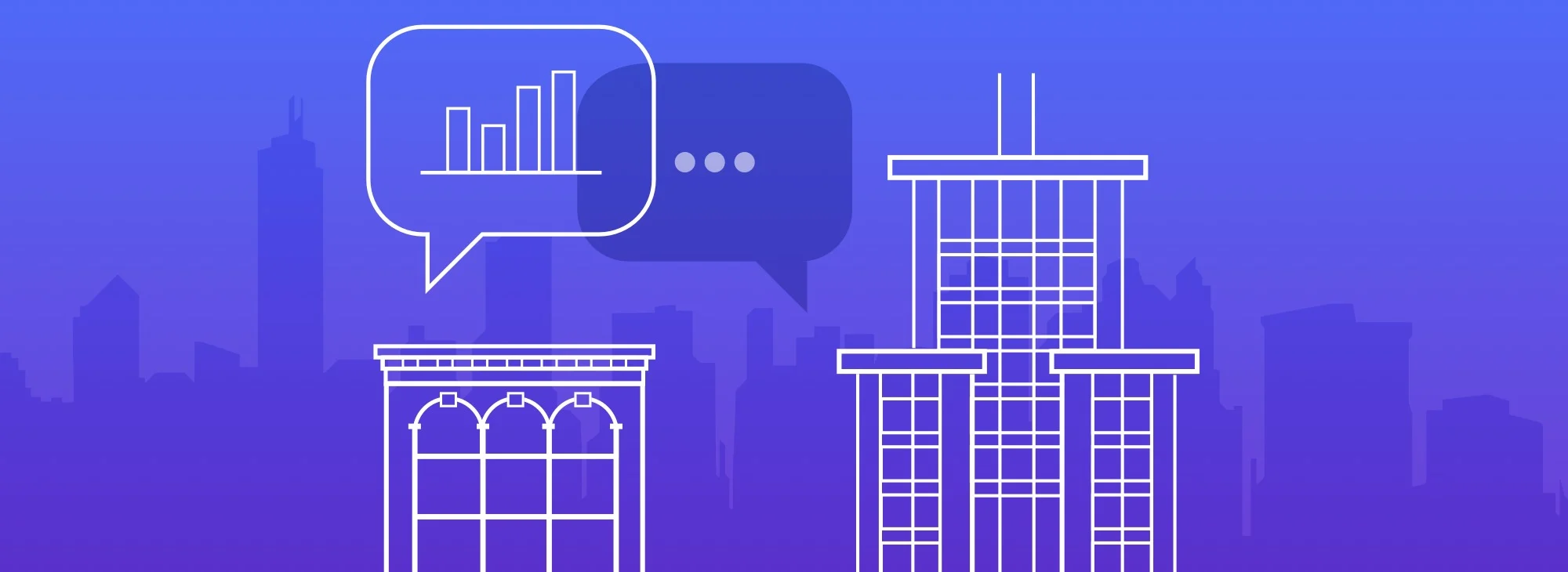
No one can deny how big the ecommerce market is. Global ecommerce sales are projected to nearly double to $6.5 trillion by 2023. Its share of total retail sales is also growing, particularly in the wake of the COVID pandemic.
So we know the sector is massive, but how complicated is it? Surely it is just a simple matter of finding the product you want, buying it, then waiting for delivery. Or is there far more to the ecommerce customer journey? There are multiple factors, from lead times to customer service, that makes an ecommerce business a good ecommerce business (or not).
Modern business, especially ecommerce , is about identifying and utilizing the best tools available. And that covers everything from live video conference software to good CRM management systems.
Smaller businesses need to find such tools without breaking the bank. Fortunately, they can choose from the best free business apps that will provide great service without denting the budget. Having the ability to be agile and to adapt to changes can be a major positive for your business.
If you look at a successful online retailer such as Larq , you will see a well-constructed site that is easy to navigate and that also offers links to their various social media platforms. This is a good example of how an ecommerce site should look. It shows they have looked at the customer journey and optimized their site to make it a positive one.
You need to know each stage of that journey, how those stages affect customer experiences and their relationship with you, and how you can improve the journey at every level and customer touchpoint . Let’s look at how the customer journey unfolds and what factors of customer journey mapping that are important for you to understand.
What is the Ecommerce Customer Journey?
That quote about life from Ralph Waldo Emerson can also be applied to ecommerce businesses. While it is easy to think about the destination—that purchase arriving in the customer’s hands—it is also very much about the journey and what happens en route to that final destination. Just as with life’s journey, every stage of the ecommerce journey has its own features and qualities.
Our customers no longer buy just a product, they buy the whole experience of being a customer, they buy your brand qualities, your mission and values, and more. They buy into the ease of your processes, the information you provide, the convenience, the quality of your aftersales (and presales if needed) customer service. In short, they look at the whole package you offer.
We all do process mapping for our businesses as a matter of course, so we should be doing the same for the customer experience. You need to understand every aspect of how your business operates, from dealing with logistics to ensuring your customers are happy.
And do not be afraid to use shortcuts. The very reason tools such as templates are offered is to make it easier for you to conduct business. They can save you time and money and it can be easy to find one that suits you.
It is not only the price of something that matters to them, it is everything that surrounds it, including how they access your site or app (and how easy it is to use), how you communicate with them across different channels, possibly even using companies like Slack , and how quickly you respond to their inquiries. In short, it is about providing an ecommerce customer journey map that meets all of their needs.
Focus not only on your customers’ journeys, but also on their relationship with you; that’s important whether you are a small business or a large international one. Investing in customer relationship management (CRM) software is highly advised, especially when you have a multichannel or omnichannel business.
There are also other aspects to consider. Many people now ask ‘ what is affiliate marketing ’, as offered by MaxBounty, and what is its place in online retail? If you use a strategy such as affiliate marketing, then you need to make sure that a customer’s journey is consistent across all the options open to them. Whether they find you via your own channels or through an affiliate.
5 Stages of the Ecommerce Customer Journey
So we recognize that the customer journey is far more than a simple buying process. We also recognize that we need to know how to develop a successful ecommerce fulfillment strategy that helps us win and retain customers. Knowing the main stages of that journey is essential to both mapping it and ensuring that it is as optimized as possible.
And when a business operates across many channels (omnichannel or multichannel ), you need to recognize that their journey may differ greatly depending on which channel they are using.
1. Awareness.
Every journey has a starting point, and in the ecommerce business, that starting point is awareness. This is the stage where the customer discovers your product/service and your brand. This is also where you discover how they found you. Did they find you via a search engine (thus validating your SEO strategy)? Did they see an ad on social media or in a more traditional medium?
You can not only see where they came from but also what behaviors they are showing once they have ‘arrived’. Do they look at particular landing pages that give you an idea of what products they are interested in? You could also describe this as the first learning stage; the customer is learning about your business and you are learning their preferences and needs.
2. Consideration.
In this stage, the customer begins to show real interest in particular products or services and move beyond general browsing. For example, with a cosmetics company such as Bliss World , they may start looking at the vegan skincare range, letting you see that this is their specific interest product-wise.
From your organization’s perspective, this stage of behavior allows you to analyze what works and what doesn’t. Those analytics can help you reduce bounce rates and encourage further investigation by the customer.
3. Conversion.
One of the magic words in ecommerce, but this stage is not always a guaranteed sale. In some cases, this stage can include those customers who have added a product to their cart (or to their wishlist) but have not yet proceeded to actually buying it. In most cases, though, we do consider this to be the stage at which a prospective customer becomes an actual customer who adds to your conversion rate.
It is at this stage that you as a business have to begin delivering on any promises you may have made to get the customer to this point. Part of that delivery is making sure all your processes, such as marketing, sales, customer service, etc., are aligned and are delivering the same message and quality of service.
4. Retention.
Another of those magic words. Having a customer make a single purchase is satisfying, but having them return again and again to buy is even more satisfying. This means they are very happy with most or all aspects of their journey and experience to date. From this point they begin to exhibit brand loyalty and may always look at your site before others.
The thing for businesses to be aware of at this stage is that providing an excellent experience once is fairly easy, but providing it time and time again is where the challenge lies.
5. Advocacy.
This stage is the Holy Grail of the customer journey but do not expect to achieve it with every customer. Most companies fall short at stage four, but those who do manage to retain customers are then hoping that those people become advocates and brand ambassadors with a high lifetime value. At this stage, your best customers are not only buying but interacting at a high level.
They will interact with you across most if not all of your touchpoints, such as your homepage, any blogs, social media, etc. More importantly (from your marketing perspective), they will be sharing information that you post on their own platforms and will actively advocate and talk about your products/services. That can also include recommending you to people and writing reviews.
Building an Ecommerce Customer Journey Map
An ecommerce customer journey map is a visualization of all the potential experiences a customer may have with your organization. Such a map also highlights the sequences those experiences are most likely to occur in. It can allow you as a business to identify strengths and weaknesses, and thus make improvements where needed.
That customer journey may consist of all the stages we previously listed or they may only cover some of them, if customers do not move to later stages. What you need to focus on is that a customer journey map will show you all the possible permutations of what the customer experiences, whether only one or two stages or all five.
How Do You Build Ecommerce Customer Journey Maps?
Being able to map the customer journey offers many benefits, but if you have never undertaken this exercise before, where do you start? What things do you need to consider before starting?
1. Perspective.
The first important thing to note is that you need your map to be from the customer’s perspective. So, detach yourself from your professional role and start the process as if you were an everyday customer. This can also help you understand the overall customer persona.
To do so, pick a product or service your company offers. Use various terms on search engines to see what results come up. Read any associated material including reviews, articles, and blogs. Then visit your actual site to view the product there. Take notes on how the various customer touchpoints felt and how the experience of visiting the site unfolded.
2. Research.
Put together a focus group that consists of your main demographic targets. Ideally, they will not know what company or brand has formed this group. Pick one of your products or services and ask the focus group to find and buy that item online. Observe and record how they find the item, what paths they take, and what outcomes unfold.
Once the focus group has finished their exercise, take the results and compare them with your experience from part one. By analyzing the two exercises, you can see if you and your customers think in the same way, and will also have a wider overview of touchpoints and interactions.
3. Understanding.
You now have a better overview of how customers interact with your business and how the various touchpoints perform. You now need to understand what those various actions mean in terms of engagement strategy. Did any touchpoint perform particularly badly? By analyzing the information you have collected, you can see what action you need to take next.
Your aim is to have your ecommerce site performing at an optimum level at every touchpoint you (and your customers) have identified. Those touchpoints can range from your own site to your social media platforms to search engine rankings. They can also include independent touchpoints such as review sites.
4. Goals and pain.
You now have some of the foundations of your customer journey map in place. But it is more than just identifying the touchpoints and engagements you have observed. You also need to understand the goals of the customer and the pain points they experience. It can help greatly if you list some of the insights gained from your observation and data collection:
Goals . What is the customer’s ultimate goal(s)? What is it they want to achieve?
Emotional response . What parts of the process make the customer happy? Or what elements make them unhappy or frustrated?
Pain points . What things cause issues for the customer and would they like to see improved?
5. Visualization.
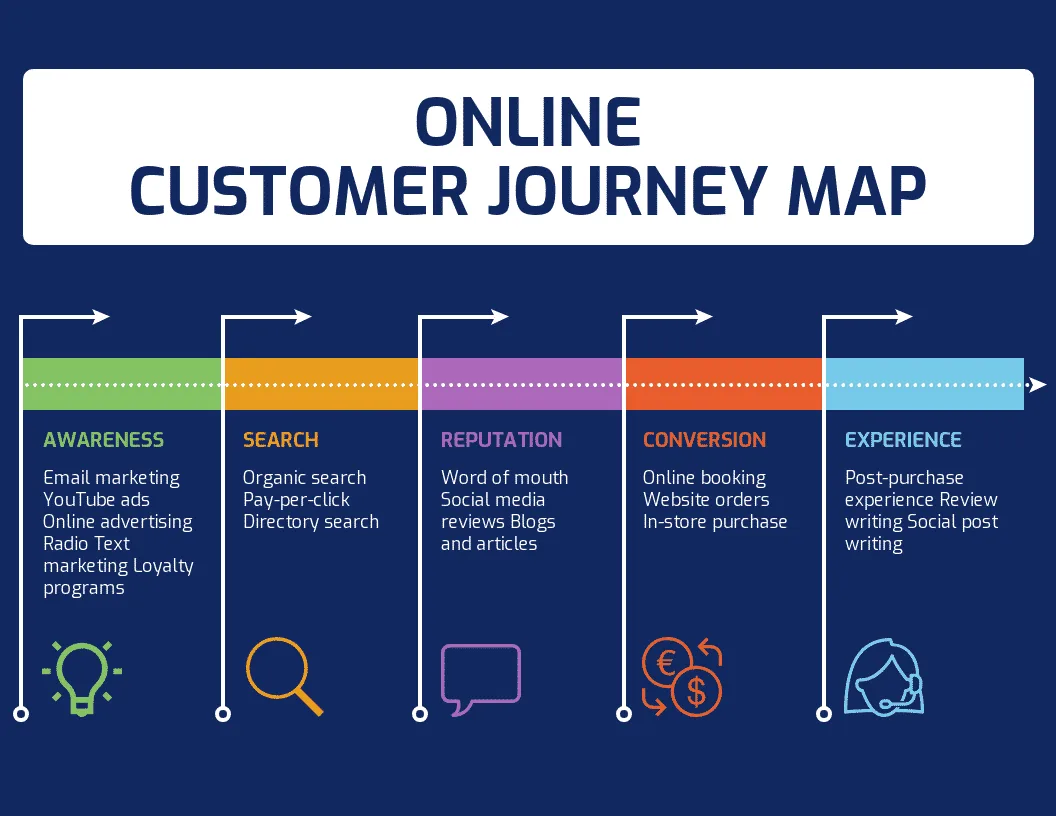
Image source
You should now have enough (likely a lot) of information that tells you what the customer experiences. The problem is that this information is not easy to digest, so you want to simplify it and create a visual that is easy to look at and understand. How you format it will depend very much on your own specific business model.
You may decide to create more than one visual, especially when you are a larger company and may have different teams working on different areas. For example, if you have a dedicated social media team, you may decide to create a journey map that particularly pertains to social media touchpoints, pain points, experiences, etc.
Why is the Customer Journey Important?
Do you really need to make a customer journey map? What benefits does it bring you? Knowing why it is important is as crucial as understanding the whole process itself. There are many reasons why it is not only important, but should be an integral part of your ecommerce business.
Efficiency . It can help you streamline the customer experience and journey by identifying if there are too many steps or touchpoints between the customer starting their journey and ending it.
Effectiveness . Does the required journey make sense to your customers? Acknowledging that we all do things differently, from how we search to how we navigate a site, creating a process that has a general effectiveness for most is a major benefit of a customer journey map.
Understanding . Knowing and understanding your customers, how they think, what they need, what they like and don’t like, is another crucial factor in determining how to create the best possible customer journey. In fact, this is an area where many organizations fail as they focus more on creating the perfect journey for them, rather than their customers.
Setting goals . A good customer journey map can help you identify and set better and more realistic goals. The combination of a human perspective and the hard data you have collected ensures you are more in touch with what makes your business thrive and grow. It also helps you monitor and tweak in real time as you move forward.
Planning . Every business has one eye on the future; new products and services, expansion, etc. Having an accurate customer journey map, and understanding it, means that you can more accurately focus on those future events.
Reducing pain . Pain points are the bane of any online stores and can lose you customers if not identified and remedied. You may be surprised by how many pain points exist once you have completed your journey map. Once you have identified them, you can take action to remove them or to reduce their effects.
How Ecommerce Stores Can Improve Their Customer Journey
For companies looking closely at their customers’ journeys for the first time, it can sometimes be daunting when flaws and gaps are identified that are having a very real effect on your business. Mapping the customer journey is one thing, but knowing how you can act on the data you have identified and improving the customer journey and experience is another.
1. Create touchpoints at every stage.
Anywhere a customer interacts with your brand is a touchpoint. Seeing an ad, visiting your site, looking at independent reviews, contacting your business to find store locations, and finally making a purchase. All of these are touchpoints. Going back to the five stages of the customer journey we discussed earlier, you need to have touchpoints for each stage.
Each touchpoint serves a purpose and plays its part in optimizing the overall customer journey. So each touchpoint you create has to fulfil its specific purpose (ad attracting interest, checkout process quick and uncomplicated, etc.) Ensuring you have multiple touchpoints that fit their respective stages and work properly is essential.
2. Optimize your website for every device.
It is worth remembering that around half of all internet traffic originates from mobile devices . So if your website performs poorly when accessed from a mobile device, you are in effect alienating half your potential customer base. Optimization is key to offering a good experience to all.
It can help to look at great websites that are well optimized, such as Skullcandy , so you can see what is needed. The screenshot below shows how well you can view their products from a mobile device, making online shopping easier for customers.
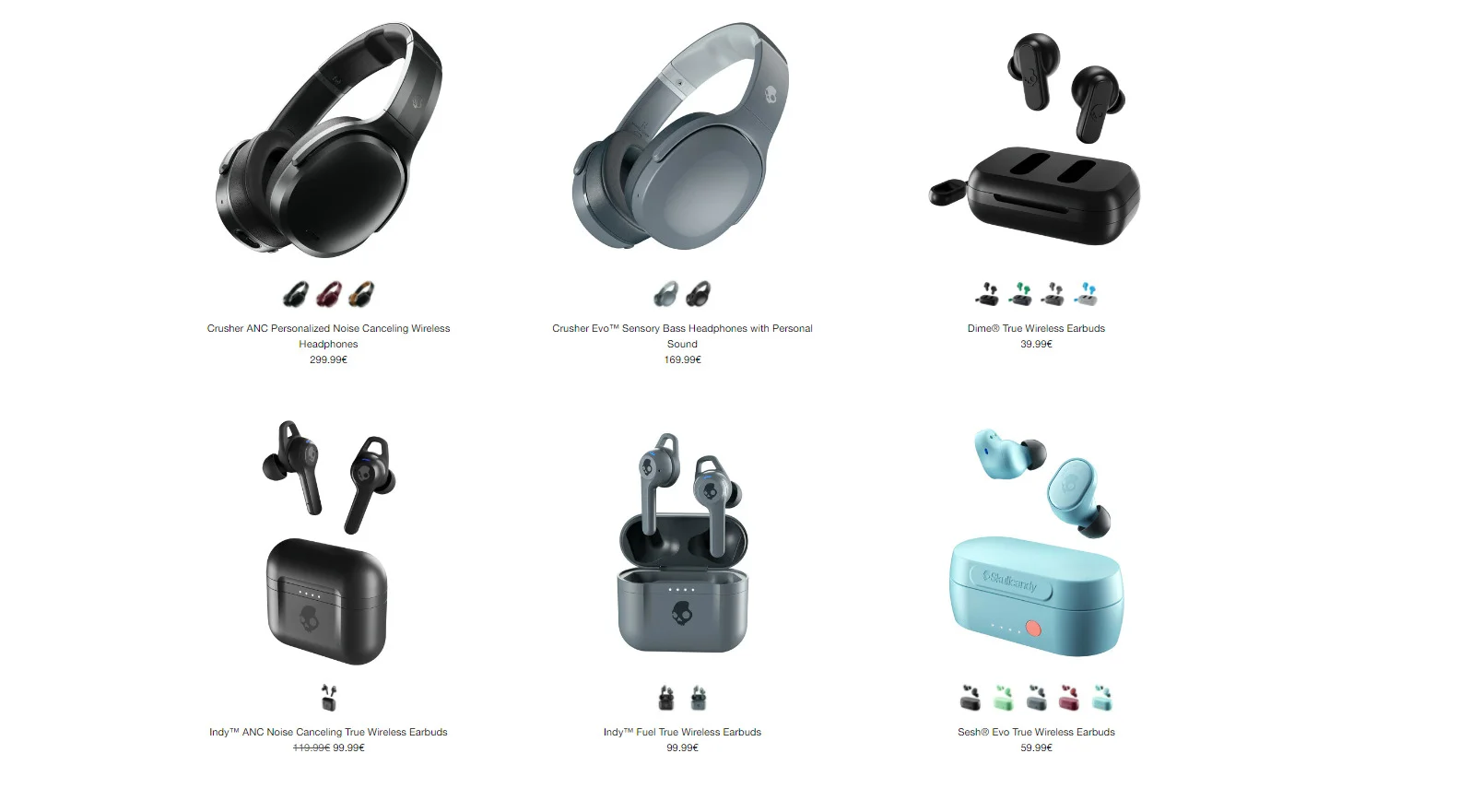
And there are a few factors to take into consideration when optimizing your site:
Test your site . Knowing your site works well on mobile devices is absolutely crucial. You can do this manually at first simply by accessing your site via several different devices. Look especially at loading times and how the site looks on a small screen. For more in-depth testing, use Google’s free testing tool .
Web host . Make sure your web host offers the speed and resources required to make your site fast and responsive. A slow and unresponsive home page and website will put customers off. You also want a host that guarantees the minimum of downtime.
Apps . Consider launching an app to complement your website. They are not as expensive as you think and they can help boost both sales and engagement .
3. Use proactive customer support.
Don’t wait for problems to happen and for customers to contact you. Anticipate the problems or questions most likely to occur and provide answers and solutions that will keep your customers happy. Offering proactive customer support has a number of benefits.
Better customer retention rates. Being proactive means you’re more likely to have happy, loyal customers.
Less calls to your support team. By solving problems proactively, customers can see the solutions themselves and thus will make less calls to you, freeing up your team to deal with more complicated queries and also reducing waiting times.
More first time customers. People talk about the good service they receive and that includes proactive support. When satisfied customers share their experiences, that can lead to new first-time customers.
Increased productivity. Proactivity means better communication. And that means your team has more time to listen to and help customers who call and to collect more information and data.
Communication. You are probably already using video and messaging collaboration tools for sales teams , so why not ensure you also have great tools to communicate with customers. Chatbots and AI are great ways of proactively helping your customers find information.
4. Personalization is key.
It is neither a secret nor a surprise that people like a personal touch, and that is true whether in ‘real life’ or in online shopping and ecommerce marketing. That means going beyond using their name (which you can do with website automation or in marketing emails) and also recognizing their particular interests and buying habits.
Using tactics such as dynamic content marketing, which can customize content according to buying preferences, location, age, gender, etc., means you are offering a personalized approach that can lead to increased sales and better customer retention. Automation and analytics can be the two drivers when it comes to personalizing the customer journey, so use them wisely.
Smaller businesses may feel they could be overwhelmed by these demands, but with so much technology and automation available on a budget, it is not that difficult to do. There are many mobile apps for small business owners that can help with factors such as communications and social media posting, so see what tools can both help you and save money that may be spent elsewhere.
5. Gather data as much as possible and be flexible.
Data is not a one off exercise. Collect as much data as possible in the early stages, but keep collecting it always. Collect data not only on customer behavior and the customer lifecycle, but also general info via surveys, polls, etc. on your social media platforms and via email. The data you collect is a hugely important resource and offers you several benefits and potential uses.
And it is, of course, not just about collecting data, but about analyzing it and interpreting it efficiently. Consider using one of the many tools, such as Google Analytics, to help you with this. Identify what metrics, such as KPIs, matter most to you. A good KPI helps show your business is healthy.
Data is not just a collection of information, it offers tangible benefits that can help your business grow by developing strategies for the future .
Understand the market . Collecting and analyzing consumer data helps you understand how your ideal customers behave online. It helps define and segment particular demographics, understand better what customers want, and see ways to improve the overall experience throughout the customer lifecycle.
Expand your database . The more information you have on customers, the bigger, and more efficient, your database is. And with detailed data, you can segment your customers (and potential customers) into groups that make more personalized strategies, such as dynamic content marketing, easier to achieve.
A larger database allows you to use a variety of strategies. For example, instant messaging can be a great way to boost your ecommerce sales.
Better marketing . By constantly collecting data, you get better insights into which of your marketing strategies and campaigns have worked well. The more data you have, the easier it is to identify which sorts of campaigns are best, and what platforms reach more of your ideal customer base and generate more leads.
Those campaigns could be via social media or you could identify what sort of email campaigns best drive sales.
Customer relationship management is perhaps one of the most important factors for ecommerce businesses to consider and it is worth investing in good CRM software to help with this. You may understand the customer journey, but managing that journey on an ongoing basis is a big task.
Aim to be consistent and to ensure you provide the same positive customer experience throughout every journey. Your online store has to be as accessible and helpful as any physical store would be. And that applies to every channel, platform, and touchpoint where your customers interact with you.
Ecommerce businesses range from massive multinational corporations to small solo entrepreneurs. Customers range from occasional purchasers of low value items to regular buyers of high value goods. No matter who you are or who they are, you should be aiming for parity so that every journey and experience is positive.

Pohan Lin is the Senior Global Web Marketing Manager at RingCentral, a global UCaaS, VoIP and video conferencing solutions providers. He has over 18 years variety experience in web marketing, online SaaS business and ecommerce growth. Pohan has a passion for innovation and communicating the impact that technology has in marketing.
- Jun 3, 2022
- 10 min read
The eCommerce customer journey and how to map it

Think about the last purchase you made.
How long did it take you to click ‘buy’? How many different sites, ads, emails, and stores did you check out before finally fetching your wallet?
Suffice to say that the typical buyer journey is anything but linear. Few shoppers convert right away, and every brand is challenged with adjusting their eCommerce marketing strategy to anticipate buyer movements both online and offline.
So, what can you do to stay ahead? Let’s talk more about what the eCommerce customer journey entails, and how to map your customer’s path to purchase when starting your business .
What is the eCommerce customer journey?
5 stages of the ecommerce customer journey, what factors affect the customer journey, customer journey mapping: why it’s a must, how to map the buyer journey for your business, example of a journey map.
Every so often, a buyer will take a relatively straight path to purchase. They'll search for a product, find your item, and within the same sitting, they'll complete the purchase.
But much more often, customers will be “pinballed” between various touchpoints. They’ll see between 6,000 to 10,000 ads in a day as they’re scrolling through their phones, checking their emails, or listening to Spotify. Then, once they decide to do some shopping, they’ll likely hop between Amazon, your site, and a competitor’s shop.
The eCommerce customer journey is the sum of all of these interactions (see our guide on what is eCommerce ). It begins with the moment a customer becomes aware of your brand to when he or she finally makes a purchase.
Some buyers will convert within mere days—while others may take several months or years. Tipping the scale towards the former outcome will require understanding the core stages and touchpoints of the customer journey and knowing how to make the best impact on your buyers.
Your customers’ overall journey can be broken down into five key stages.
01. Awareness
Your customer stumbles across your brand for the first time. Be it through an ad, social media, word of mouth, or SEO–they are now aware of your products. However, as noted earlier, many will not convert right away. Some may not even be looking to purchase anything at all.
At this stage, you’ll want to make sure you understand how people are finding your brand and who they are. Are they the buyer personas you expected to reach? How do demographics, acquisition source, and other factors affect what action your audience takes next?
While many visitors at this stage may just be “window browsing,” you’ve at least built some sort of brand recognition. Now it’s time to do something with it: retarget people, learn more about their interests, and guide them towards products that are most relevant to them.
02. Consideration
At this point, your buyer shows actual interest in your product. They’ve got their eyes on a particular product or set of products, and are deciding which one is worth buying.
Some may be trying to decide whether your item is a need versus a want. Others may be checking out product specs to make sure that your item is worth the price. Still others may be deal hunting or checking out options on competitive sites.
In any case, you’ll want to track which product pages people are spending the most time on, which products they’re comparing, and what other brands are on their radar. How can you convince them that your product is better? What can you do to build their confidence in your brand or incentivize a purchase?
03. Decision
Alas, your buyer makes a purchase on your site—assuming that the checkout process is easy and buyer friendly.
Your number one goal here is to make sure that the checkout process is seamless. Create a simple checkout flow, offer multiple (and secure) payment options, communicate your return policy, and provide all the information buyers need to feel supported by your brand.
Buyers should know when to expect their packages and any fees associated with their purchase. Don’t let any unwelcome surprises or lack of information lead to customers canceling their orders early.
04. Retention
Once a buyer makes their first purchase with your brand, they’ll ideally become a repeat customer . A positive customer experience—including excellent customer service, on-time delivery, and a multichannel marketing strategy—can work together to build customer loyalty .
Note that even though you’ve won the first sale, you’ll need to continuously earn a buyer’s patronage time and time again. Be consistent in your messaging. Engage buyers frequently. Offer incentives or employ strategies for upselling and cross-selling .
05. Advocacy
Happy customers have the potential to attract other happy customers. Buyers at this final leg of the customer journey are (hopefully) so happy with your product and/or service that they’re eager to spread the word to their friends and family.
Of course, this isn’t a passive activity. You’ll want to proactively nurture brand ambassadors by creating a customer loyalty program , hosting giveaways, showing appreciation, and taking other steps to inspire advocacy.
Your customers are a moving target. Between their unique preferences and backgrounds—plus their prior experiences with brands—there are tons of factors that shape the way they make their purchases.
As you track the various ways that customers interact with your brand, consider how trends like the ones below can make a big impact on the buyer journey.
Social and economic changes - e.g., the recent pandemic. These events tend to spur shifts in buying behaviors and expectations, as many types of businesses and buyers alike adapt to new realities. With each shift, consumers tend to get smarter and potentially pickier on what defines a good value and how to spend their money.
Convergence of online and offline shopping - Omnichannel retail isn’t just a concept anymore. Today, the lines between the offline and online worlds are increasingly blurred—with digital native brands like Warby Parker opening physical showrooms, and longtime retailers like T.J. Maxx investing more in online commerce. Curbside pickup, BOPIS, and in-store returns are just the beginning of what’s to come; brands should expect the customer journey to entail a greater mix of online and offline touchpoints, regardless of whether a customer originated online or not.
Corporate responsibility - Brands today are expected to do good. Inactivity or a difference in values could shape a customer’s engagement with your brand at any point of the buyer’s journey.
Choice paralysis - The proliferation of brands and products online have the ability to frustrate consumers. Make sure that your website is organized in such a way that customers know exactly where to find what they’re looking for. Make it easier for them to filter out noise and/or compare similar options. The last thing you want is for an overabundance of options—or poor site design—to deter your customers from buying. Learn more about combatting choice paralysis .
While customer journey mapping is an imperfect science, the benefits are undeniable.
In fact, 30% of surveyed retailers reported significant improvements in customer lifetime value and customer advocacy after investing in digital customer experience (CX). Roughly 23% reported an increase in average order size as well.
This exercise can help you to achieve multiple goal including:
Getting more clarity over how buyers interact with you - By carefully mapping your customer journey, you can gain a clear understanding of your buyers and their habits. A map helps you to see things from the buyer's perspective rather than your business’s perspective.
Improving customer retention rates - A map helps you to identify when and why prospective buyers are dropping. For example, an ill-worded message or one displayed in the wrong place at the wrong time could be all that’s causing buyers to regress in their journey. By making strategic changes and reducing friction in the customer experience, you can enjoy an easier time attracting and retaining buyers.
Sharpening your focus and organization - This exercise will force you to lay everything on the table–from all of your marketing campaigns to all the possible interactions a customer may have with your brand. From there, you can determine the health of each channel, who owns which touchpoint, and realistic goals for each event.
Increasing revenue - When you understand how buyers interact with your business in detail, you can more accurately cater your communications, offers, content, and promotions to influence sales. It’s all too easy to rely on assumptions or old habits when engaging customers. A journey map helps to shed light on biases and pain points that you may not have known were there before.
So how do you actually map the customer journey? Here are five steps to get you started.
Step 1. Describe your buyer personas
Before building a map, you must clearly define your target customer types. Are you looking to engage parents, young adults, or consumers with specific hobbies?
Your personas should include as much detail as possible. Make sure to base them around real data—not made-up, fake, or idealistic data. Talk to various stakeholders, interview your customers, consult social media, or perform user testing.
In other words, don't build a buyer profile based on what you think a customer should look like. Create your buyer personas using actual data you gathered from the places where they hang out and from talking directly to your target audience.
Step 2. Define the main character of your map
Now, you can decide which set of customers you’d like to analyze as part of the journey mapping process. The map will look different for each type of buyer you target, and trying to address all of them at once will only muddy the data.
To start, pick the most common persona (i.e., the most valuable or largest cohort). You’ll have an easier time collecting data this way, plus taking meaningful action from your journey map.
Step 3. Analyze on-site behaviors
As an initial step, check out the behaviors on your website and jot down the top pages that people enter your site from, where they exit or bounce, and which ones are the highest converting. Tools like Google Analytics and Wix Analytics can help to fill in these blanks.
To get more specific, make sure to filter your data according to criteria that’s most relevant to your buyer persona: geo, new versus returning users, and device (to name a few).
You may already start to see areas where people drop off and opportunities to optimize your site. You can additionally gain insight into what your buyer is more interested in buying based on where they linger on your site (though note that this could be heavily influenced by how accessible a page is from other areas of your site).
Step 4. List all other customer touchpoints
List out all the ways that your target buyer can interact with your company, both on and off your site. Include things like:
Social media
Review sites
Publications
Popup stores
Onsite banners
Physical stores
Marketplaces that you sell on
Help center
Loyalty program
Seasonal promotions
From here, you’ll want to list out all the possible actions someone could take from each channel. For instance, when someone interacts with a blog, he or she may subscribe to your newsletter, download a piece of content that you promote, click to another blog—or even request a demo. Alternatively, your visitor may bounce.
The purpose of this exercise is to audit all the CTAs you include on a single page, as well as links and other messaging that may influence a visitor’s behaviors. You’ll moreover want to look into whether reality aligns with expectations.
When you compare your list of expected behaviors with the data you gathered from Google Analytics, Wix Analytics, and other sources—do the results align? How can you better define the purpose of each channel, and match your goals with a visitor intent?
Step 5. Visualize the journey
Finally, you can document all of your findings into one easy-to-reference map. The scope of your journey map can vary depending on your goal. For instance, you could show the complete customer journey (as shown below) or hone in on just a part of it where you see the most room for improvement.
A map may cover everything from a buyer’s emotions, to their actions, to roles and responsibilities on your team at each stage. It can serve as both a tool for predicting buyer behaviors and keeping your team organized.
That said, there are several types of journey maps you can create:
Current state map - This shows how customers interact with your brand today. You could use it to compare behaviors between two different segments of buyers, or to uncover how customer emotions and behaviors vary depending on how they find your products (as an example).
Future state map - This illustrates the ideal journey that you want your customers to take. It helps your team rally around specific goals and identify critical points of a customer’s journey.
Day in the life map - This is similar to a current state map, except that it doesn’t start and end with a buyers’ interaction with your brand. It aims to understand all of their daily activities and lifestyles, with the goal of developing new, meaningful touchpoints.
Service blueprints - This takes a simplified version of one of the maps above, then adds in details about the various people, technologies, and processes that take place behind the scenes. The purpose is to audit and optimize how your team functions in the background to support the customer journey.
Let’s imagine that you own an online shop for pet supplies. You want to create a current state map in order to see how your core customers (new dog owners) are interacting with your brand. Your map may look something like this.
This helps your team keep track of the most effective campaigns, products, and channels. You’ll likely look to expand upon this map soon, as you get even more granular in your research or launch new campaigns.
There is no right or wrong way to create an eCommerce journey map. The framework outlined here is just meant to provide a good starting point. Once you have a baseline, you can continue to modify and rework your journey map to fit your unique business.
Remember that the customer journey is constantly evolving. Re-evaluate your eCommerce journey map once a quarter or at least once every six months. Aim to reduce friction in the customer journey and put assumptions to the test.

Allison Lee
Editor, Wix eCommerce
Allison is the editor for the Wix eCommerce blog, with several years of experience reporting on eCommerce news, strategies, and founder stories.
- Sell Online
Related Posts
What are flash sales? A step-by-step guide with examples
14 effective eCommerce marketing strategies for you to keep sales rolling in
4 strategies for abandoned cart recovery and how to reclaim those sales


Create an e-commerce customer journey map with a free tool
Customer journey mapping in e-commerce is a diagram that illustrates the steps your customers go through in engaging with your online business. It starts when they first become aware of your products, to completing a purchase. It can extend to after-purchase care.
Buying and selling products on the internet is as popular as ever. There are many small and medium sized businesses entering online shopping space thanks to popular e-commerce sites like Shopify or BigCommerce. If they want to build up their market share and not lose out, they need to ensure smooth customer experience.
It all boils down to one thing—
Mapping e-commerce customer journey.
It lets you understand customer's complex interactions with your brand and meet their needs.
This article covers the following topics:
- Why journey mapping for our e-commerce is important?
- Creating an e-commerce journey map with examples
- Online shopping challenges and how to solve them
- Bonus: e-commerce journey template
Why is journey mapping in e-commerce important?
Designing a customer journey map in e-commerce is key to:
- Understand customer interactions across different touchpoints (ads, newsletter, T&Cs, customer support, and many more)
- Identify customer's pain points
- Improve satisfaction scores and increase the number of returnig customers
- Improve existing operations based on concrete data
- Identify potential new target groups
- Strategize how to reach customers in the future
Sounds good?
Let's see where to start!
How to create an e-commerce customer journey map?
At Smaply, we know the ropes of making customer journey map . So even if you have never done this before, we'll guide you through the process. You can even use Smaply's free customer journey mapping software with our tips and tricks to speed the process up.
1. Empathize with customer personas
There is no customer journey map without a customer. So you have to think about who our customer is—or should be to understand their needs and expectations.
The first step is to create a persona that represents this target group in a customer-centric way. Defining a persona in e-commerce can help you answer some important questions:
- What does the user need/want?
- What channels and devices does the persona use in order to research products?
- How price-sensitive is the user?
- What are their concrete expectations about their online shopping experience?
- What products does the persona value?
By answering these questions, you can get a better understanding of your target group. The questions above are just examples. You could also include country specific questions or cultural differences. Just think about which information might be helpful for their e-commerce journey.
Check out the example profile of a persona in a customer journey map for an online shop.

Keep in mind that when you run an online shop, you should also examine potential customers or leads.
2. Define the scope of the e-commerce journey map
When creating a journey map, you can choose between various scales and scopes.
When you start out, we recommend that you use a high-level journey map to visualize the whole experience the user has with your brand. From finding to your e-commerce site, searching for the right product, the check-out process, and up until the product delivery.
Then, you can create a more detailed map to dive deeper into a specific step. For example, you might want to focus on the product search on your website through different category pages or the check-out funnel.
Many e-commerce shops lose customers during the check-out process. It might be useful to investigate this step. Is the process intuitive? Or is it confusing for customers?
3. Analyze experiences, step by step, stage by stage
Now, we have to map down the user’s journey.
Every e-commerce journey map consists of several stages and steps:

Once we’ve defined the stages, think about the different steps and touchpoints customers experience when they are interacting with your online shop. The level of detail of each step depends on the overall scale of the map that we’ve defined above. Ask yourself:
- What are the steps within each stage?
- What are the customers’ goals and pain points at each step of the journey?
- What are your own business goals for each step?
- Where do your current customers drop out of the journey, leave our website?
- Do they get the right information at the right time?

There's one important thing to keep in mind at this point—
The customer journey starts before users get to our website. It starts with a need, a desire for a more or less specific product. Also, the customer's e-commerce journey does't end at the checkout. Nor when users hold the product in their hands.
Customers experience and interact with your brand after completing the online purchase. For example, when contacting support, returning to your shop, or recommending the brand to their social network.
5. Visualizing processes
This is an often neglected step in mapping e-commerce journeys.
You can also focus on the backstage activities happening during the journey. What needs to happen behind the scene, outside of the customers’ view to deliver a smooth experience? Close to a service blueprint, visualizing different levels of processes helps webiste owners better understand who’s involved at what step of an experience and who is responsible for their optimization.
In the below map you can see a strong focus on enabling processes could look like.

For comprehensive and complex journey maps with advanced lane and content types like those above, use a digital customer journey mapping software .
Examples of journey maps in e-commerce
This simple e-commerce journey map illustrates the steps of two different personas and compares their experience. It visualizes:
- Channels they use
- Their emotions
- Involvement (dramatic arc)
- Ideas for improvement
- Backstage lane that provides a rough idea of the processes that are invisible to the customer
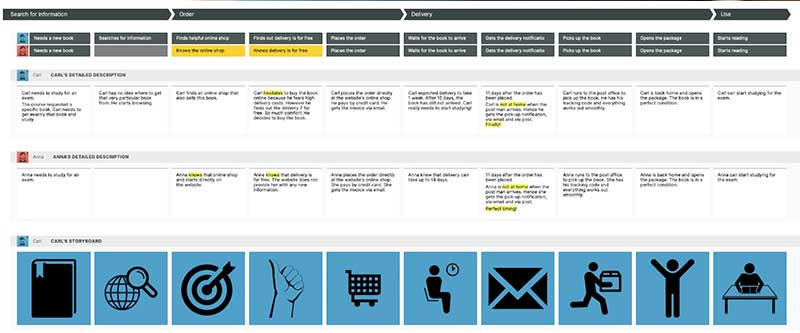
This example of online shopping experience map shows a strong focus on backstage processes. It clearly differentiates between processes that are visible to the customers, and processes that aren’t. Hence, it gets very close to a service blueprint.
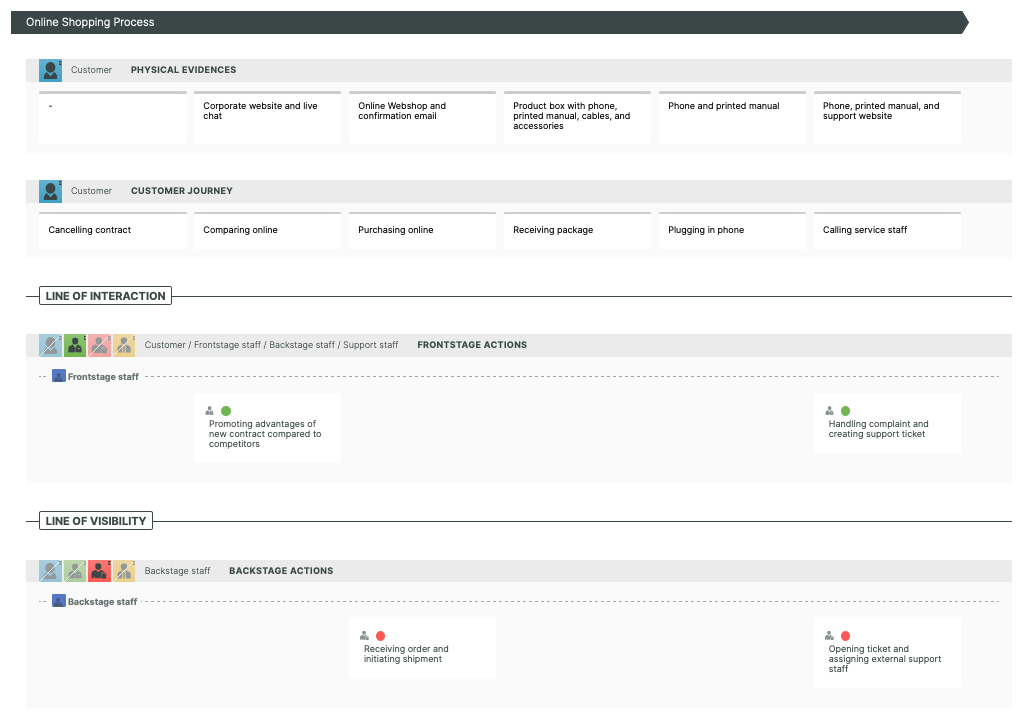
What are the challenges of mapping journeys in e-commerce?
Getting lost in all the data.
In e-commerce, it is common to collect loads of data about users, their preferences, purchase history, and needs. It can be extremely useful and help get a better and more holistic understanding of your customers. However, using all this data too early in the process of mapping e-commerce journeys can prevent you from understanding of the big picture.
Quantitative data (e.g., from Google Analytics) is a good resource for sure, but remember to look at qualitative data, too. For example, try to interview some of your customers after the purchase or send them a customer survey to get some qualitative insights.
The good thing about qualitative data is that it helps us find the biggest pain points easily. If there’s a hole in the street and three pedestrians point to it, we don’t need another 10 folks to confirm this, right?
Also, quantitative data will never give you an answer to the “why”:
- Why did users visit your page?
- Why did they buy from your site, and not another?
- Why did they abandon the cart?
Some more questions that could be interesting to dive into are:
- How did they research the product in the first place?
- What online and offline channels did they use?
- How do they evaluate the experience on our website?
- How do our users think your page could be improved?
Consider context and think cross-channel
Many different channels influence the e-commerce journey: website, shopping app, review portals and word of mouth…
Even though a big part of a service is being used in an online context, it does not mean customers don’t have any offline experiences. Consider physical context and direct, personal interaction! Is your online shop accessible to everyone? What do customer reviews tell others about your customer service? This is something you will learn from Google Analytics!

Empty template for an e-commerce journey map
It’s time to create your own journey map!
Download this set of paper templates , or start creating digital journey maps with Smaply !
Create user-focused journey maps to understand the user experience and innovate your services. Smaply lets you easily create e-commerce journey maps, personas, and ecosystem maps with an in-app template.
Sign up now, it's free!

Antonia Cramer
Antonia keeps her eyes open for questions people interested in service design are looking to answer, and helps us provide resources to support their learning ambitions. With her background in digital communication she has great knowledge on how to create content that is easy to access and understand.
Related articles

Ask Marc – about presenting journey maps

What is patient journey mapping and how to do it?

Podcast: talking about Journey Map Operations at 'This is HCD'
Sign up for the Smaply newsletter and get inspiring news about CX management, industry insights, learning resources and much more.
- Woopra Logo
- Platform Customers Pricing Resources Company
- Log in Start For Free
- Automations
- Integrations
- Documentation
7 Interesting Real-Life Customer Journey Map Examples

Creating a customer journey map is vital for any business to optimize its sales and marketing processes.
According to Salesforce , “among high-performing teams, 88% say a customer journey strategy is critical to the success of their overall marketing.”
An effective customer journey map will include each customer touchpoint a shopper interacts with on the way to making a purchase.
If you’re looking to create this document from scratch or looking for ways to improve your map, below are some customer journey map examples from highly successful companies.
Customer Journey Map Examples
When doing customer journey mapping, you should think deeply about your business and the customer experience. On that note, let’s dive into some real-life customer journey mapping and walk you through what makes customer journey maps so valuable.
Consumer SaaS Customer Journey Map Examples
Customer journey maps are essential to B2C companies in the SaaS space. It can be expensive to acquire a new customer and each month that you’re able to keep a subscription active deepens your ROI and ROAS.
Understanding each customer interaction, pain points and customer needs is vital for maximizing value throughout the customer lifecycle - and a user journey map will help identify these areas.
Spotify is one of the world’s most popular audio streaming services. When Spotify wanted to improve the music-sharing experience for its customers, it hired a marketing firm to create a customer journey map .
The goal of this user journey map was to determine where music sharing features the best fit into the customer experience .
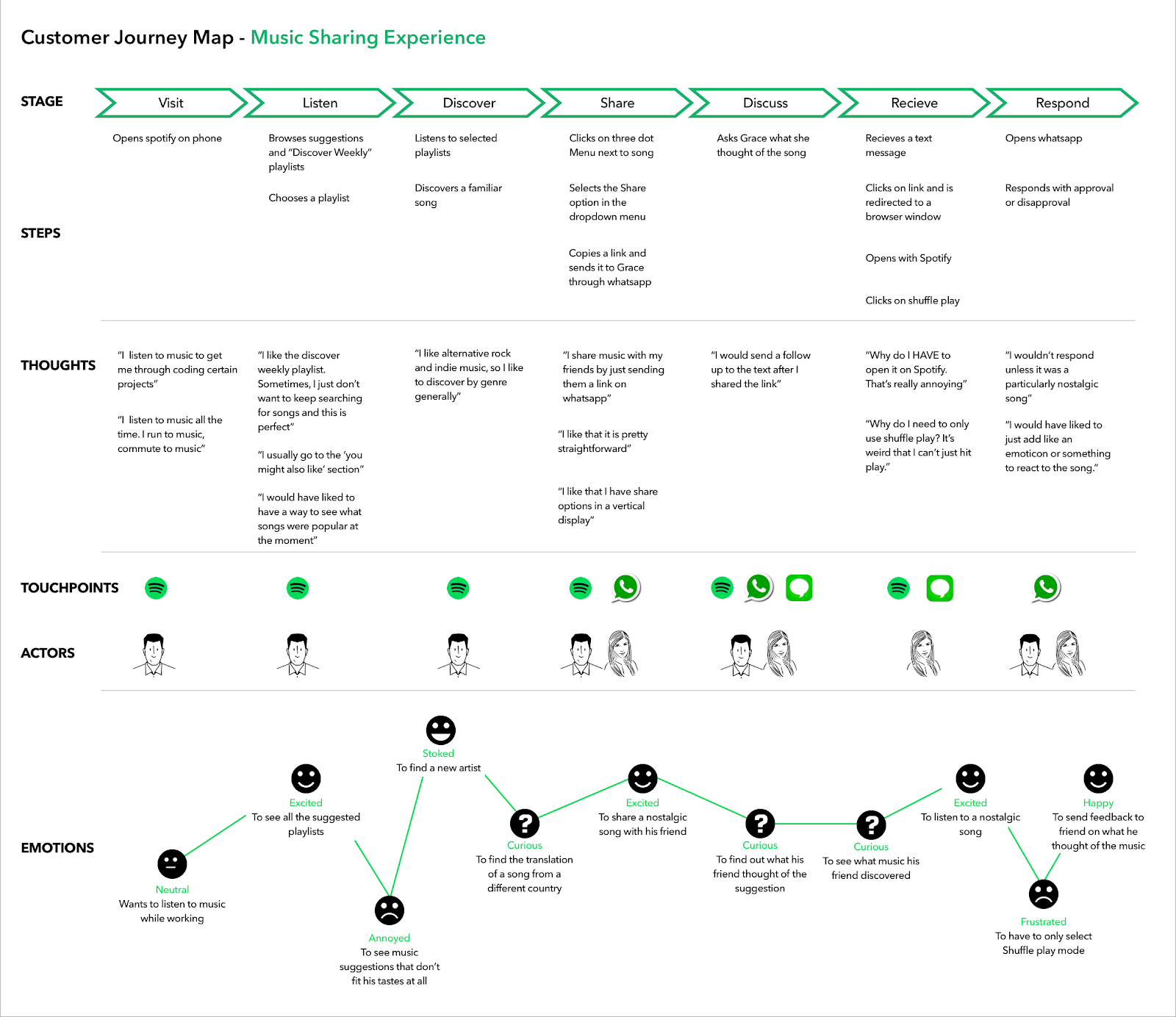
In this example, we see the user experience mapped out from the moment the user first opens Spotify on a mobile device, all the way through to whether they like a song that a friend has shared.
Also Read: Effective Customer Journey Design
Throughout each stage and every touchpoint, the brand lists what a customer is engaging with, doing, thinking, and feeling (something that's commonly done with an empathy map ). The agency used data research and customer surveys to better understand how users felt at each touchpoint in the customer journey to collect this information.
Based on the customer journey map, Spotify was able to identify pain points for users and address those pain points so that the music sharing experience is smooth and seamless, encouraging more users to share music -- and to do it more often. \
This journey map is excellent because it identifies key areas of customer engagement, takes into account customer behavior , and has the goal of making the customer experience as enjoyable as possible.
The end result is significantly higher customer satisfaction, which can have several key benefits, including a smoother buyer journey, greater customer loyalty, and in many cases, existing customers becoming brand advocates.
2. TurboTax
Turbo Tax is a leading online software package for preparing taxes. When the TurboTax team was ready to launch a new product called Personal Pro, they created a customer journey map to better understand the overall customer experience with this new product.
The team used a mix of data research, customer surveys, and key conversations with tax professionals to understand how the product fits into the lives of those using it.
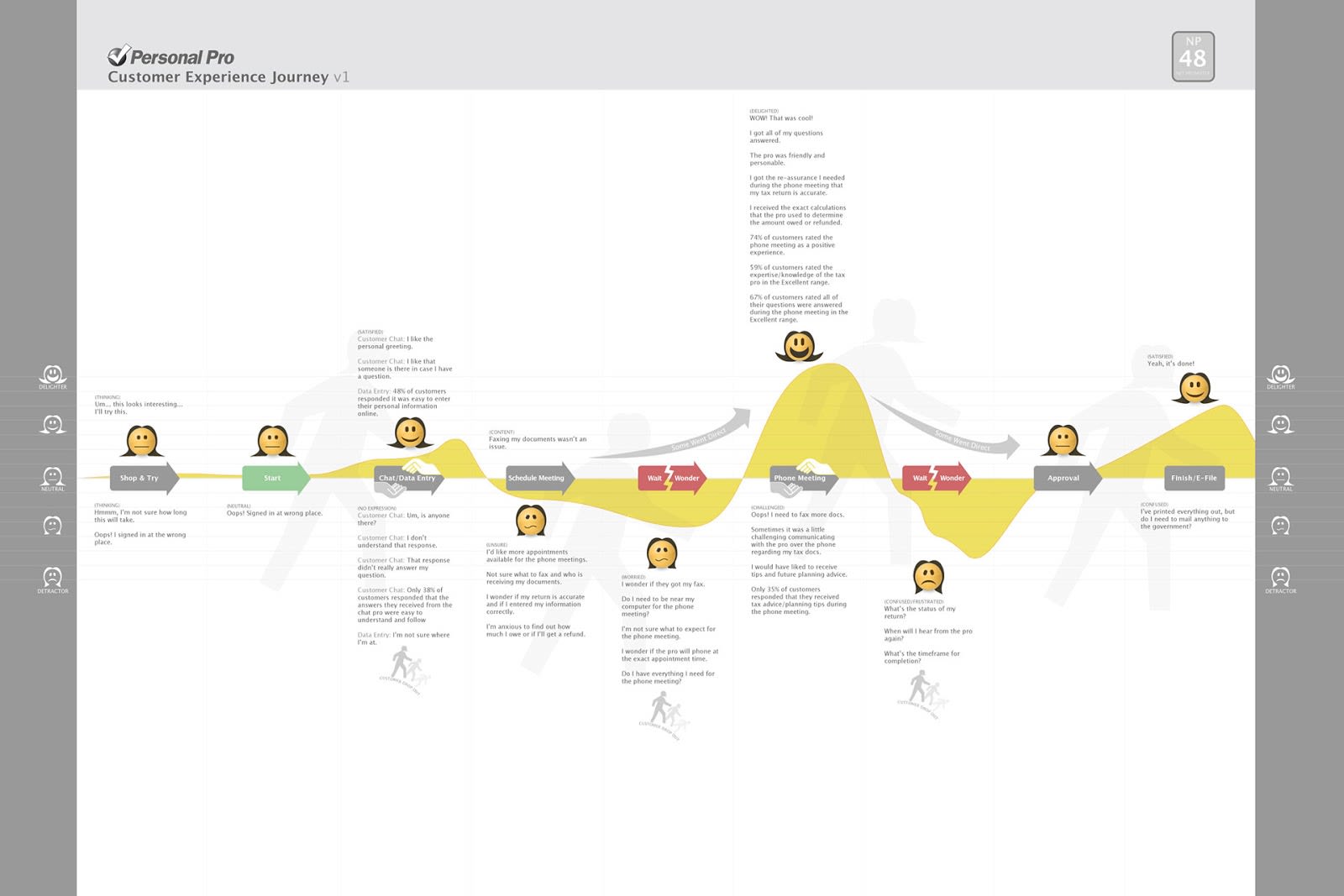
TurboTax’s customer journey analytics exercise starts when someone enters the website and is in the consideration phase through to the completion of the tax filing.
This customer journey map is great because it allows the team to see each customer pain point experienced and, therefore, address these pain points to make the customer experience smoother and more satisfactory.
Ecommerce Customer Journey Map Examples
The Ecommerce space is highly competitive in almost every niche these days. To maximize profit margins while keeping pricing competitive, it’s important to convert as many shoppers that visit your site as possible.
Also Read: Customer Journey Template
In addition to converting first-time customers at high rates, it’s important to have up-sell and cross-sell touchpoints in your customer journey as well. This increases the lifetime value of your customers and drives up the ROI against your acquisition costs.
Customer journey mapping is a vital exercise that can help E-commerce businesses skyrocket conversion rates from all online shoppers and achieve higher customer success.
1. Columbia Road
E-commerce agency, Columbia Road, created this map template for a fictitious online grocery shop . Here the agency demonstrates the core activities, goals, touchpoints, and experiences that a customer will go through during the decision-making process to place an order.
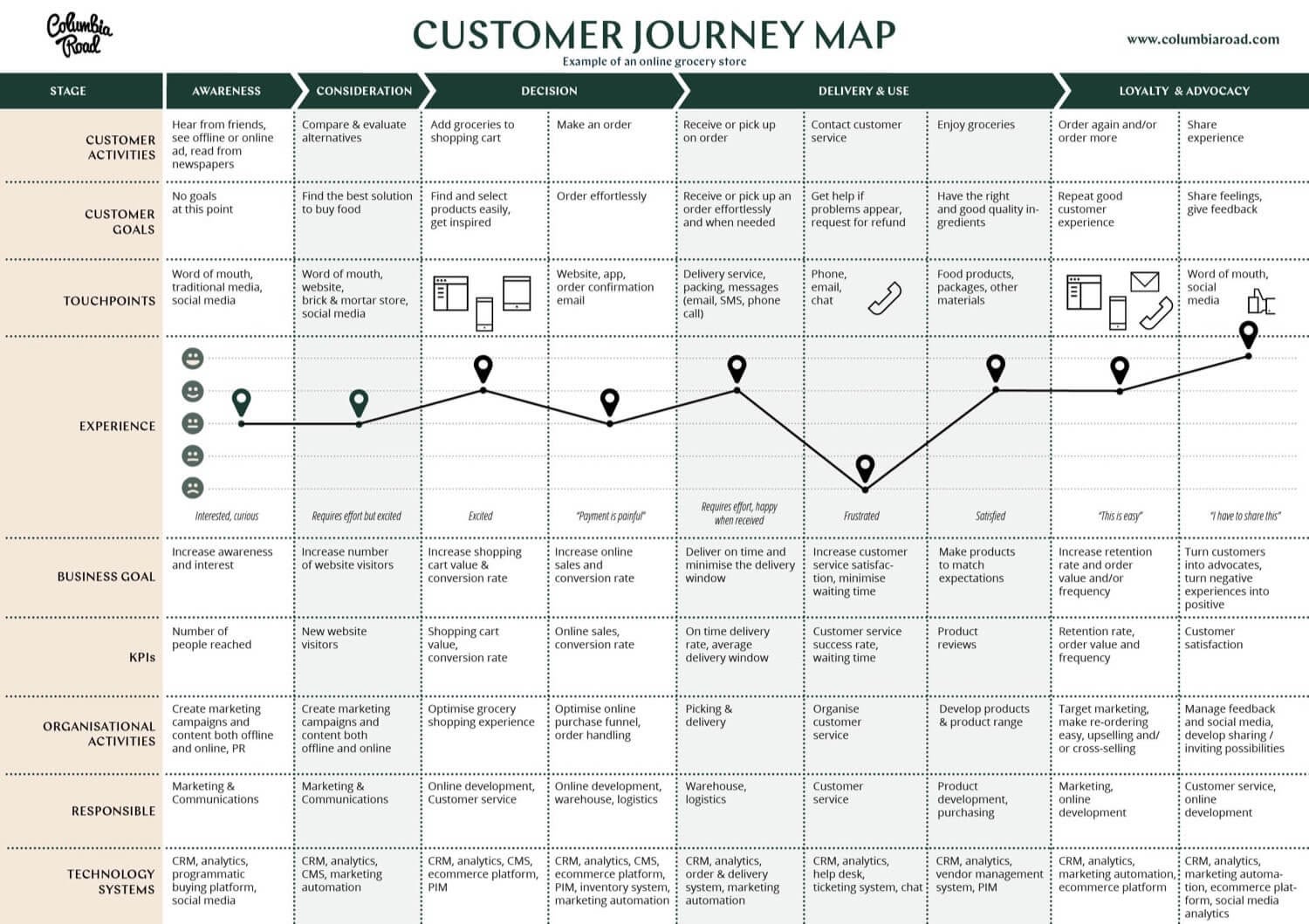
In this customer journey mapping exercise, the Columbia Road team went one step further than others by also including Key Performance Indicators (KPIs) and which department is responsible for ensuring a customer has the best experience possible at each stage within the user journey.
Including KPIs is important because it lets you know if your customer journey map template is effective or if it needs to be adjusted to better serve your shoppers.
Amazon is one of the largest E-commerce shops in the world, with its own technology and custom systems in place for moving a customer through the sales journey. Its customer journey map is one of the most complex around and would take most people days to read through and understand each customer journey stage.
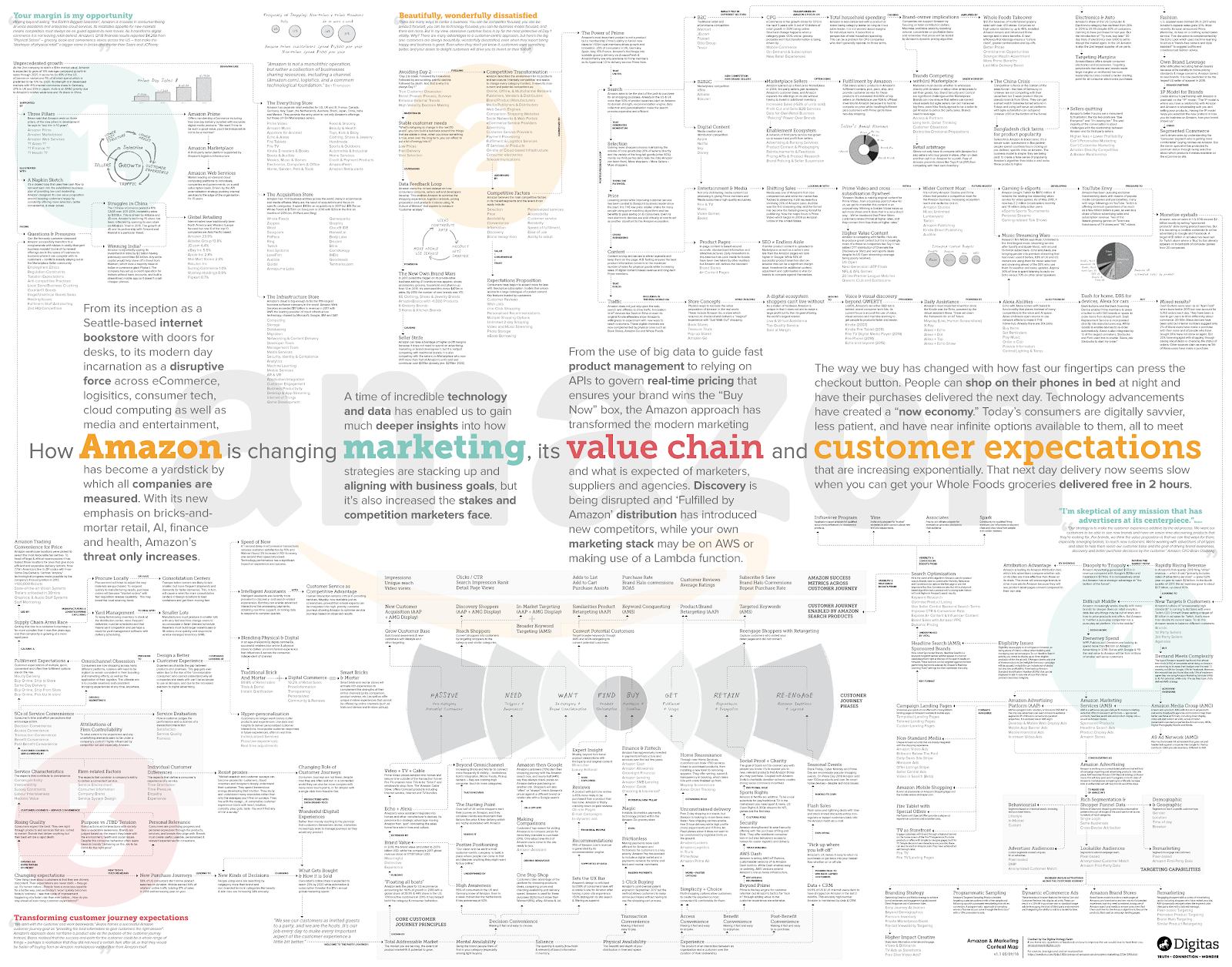
The good news is that the map can be broken down into several more digestible parts for analysis.
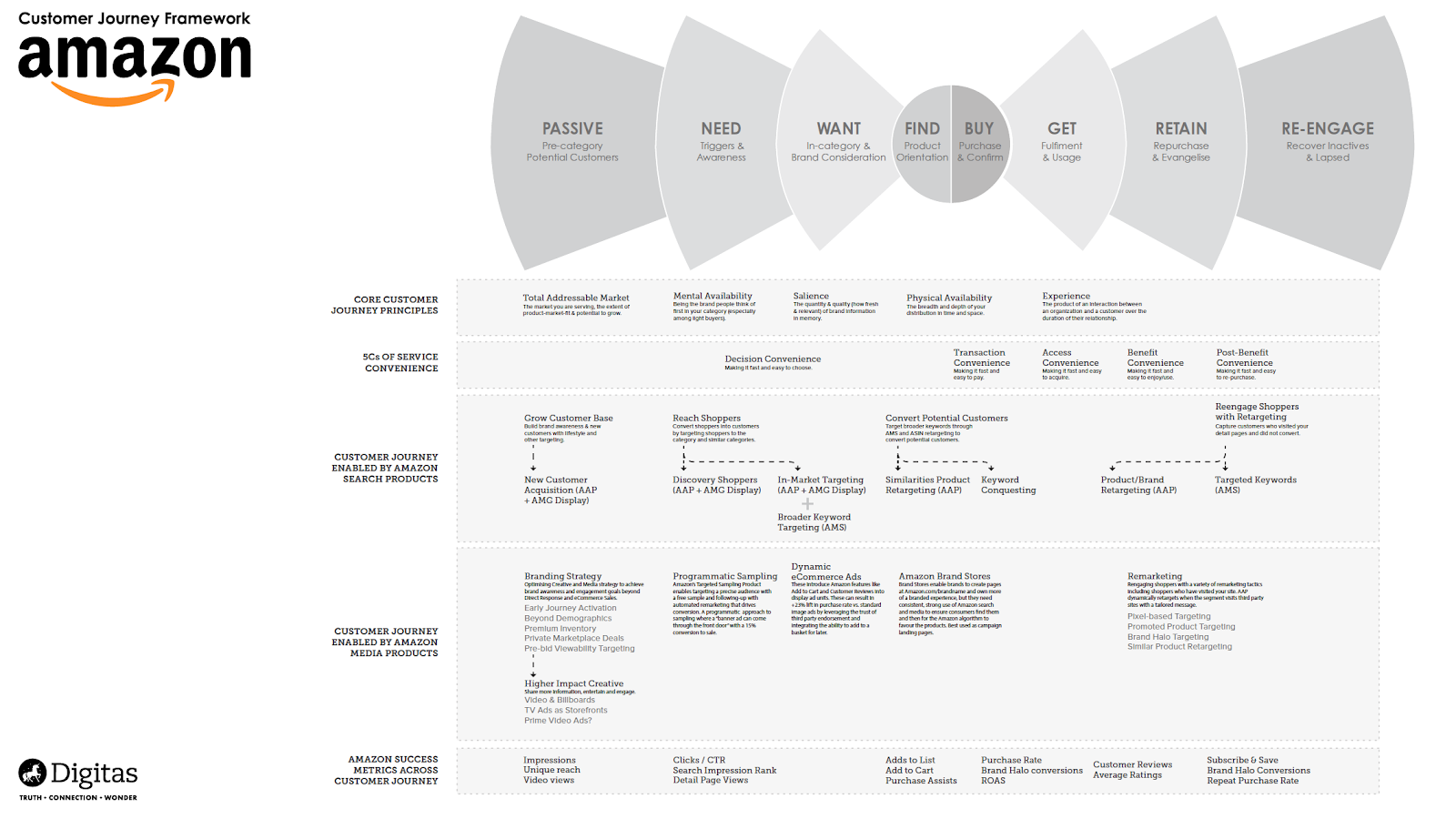
Here we can see Amazon’s customer conversion funnel and how the customer journey is enabled by its own products that push users through the sales funnel to maximize customer engagement.
Most interesting here is how Amazon includes its success metrics for each stage of the customer journey. These are the same success metrics that just about every E-commerce shop should be monitoring:
- Impressions
- Add to list
- Add to cart
- Purchase assists
- Conversion rate
- Subscriptions
- Repeat purchase rates
When conducting your customer journey mapping exercise, be sure to include these key metrics to monitor your success and gain deeper insight into the overall customer experience.
3. A More Common Scenario
If looking at the Amazon customer journey map feels overwhelming to you know that you’re not alone. Most E-commerce businesses will have a much less complicated customer journey to map out.
Here's a customer journey map template for the checkout process for online shops.
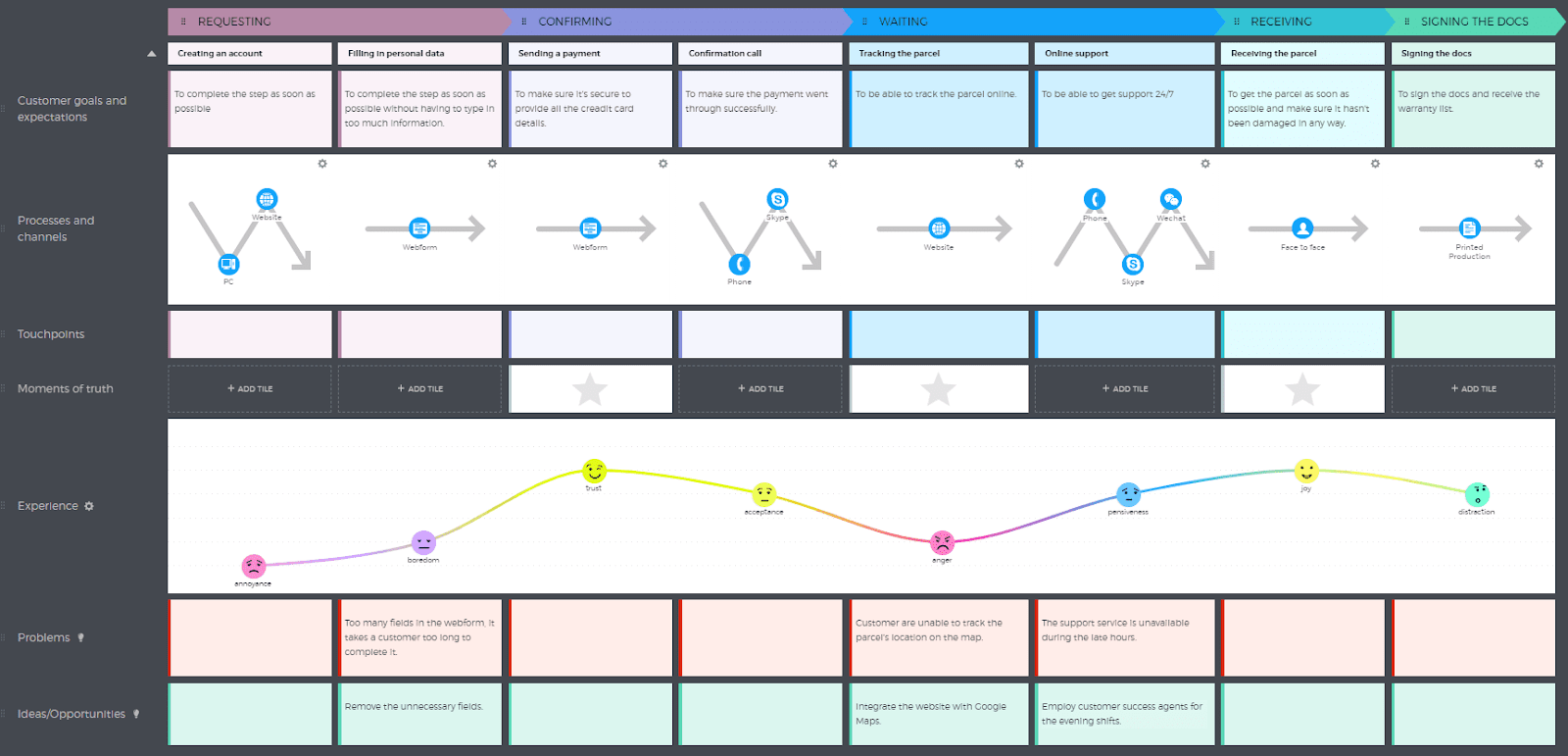
For instance, you see the most important stages of the checkout process, including the technology involved, common customer frustrations, and space to include solutions to make the process smoother.
For example, if a customer finds creating an account to be a barrier to checkout in the very first step - then offering a guest checkout option would be one solution for improving the customer experience.
Start your E-commerce customer journey mapping exercise using the above customer journey mapping template as an outline and then customize it for your own needs.
(If this isn't a good fit for your company, check out these other customer journey templates .)
B2B Customer Journey Map Examples (SaaS)
In the B2B customer journey , the sales cycle can vary significantly based on price point and the buy-in from stakeholders needed to make a business purchase.
When it comes to a B2B SaaS purchase for something reasonably inexpensive like Hootsuite’s social media management platform or the MailChimp email marketing platform, most of the customer journey will happen digitally with minimal to no involvement from a sales representative.
In this case, customer journey maps might be made using a simple Excel spreadsheet.
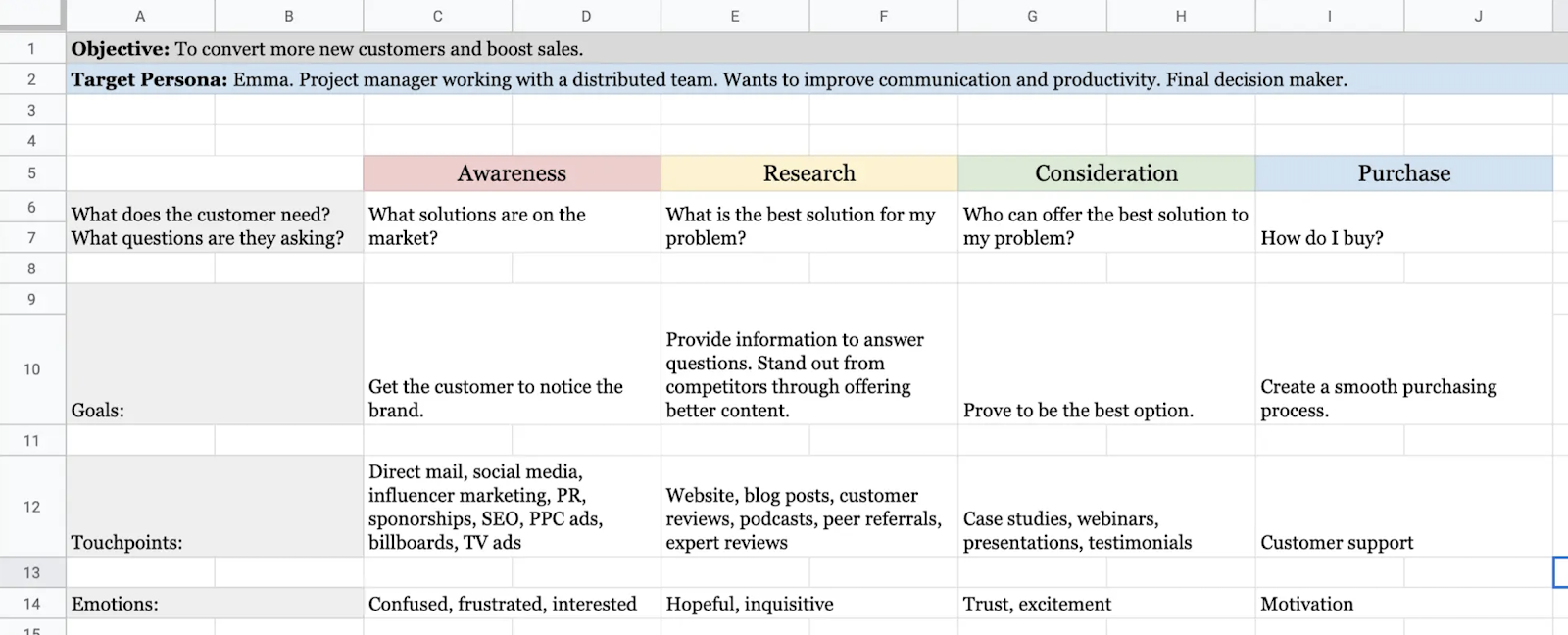
Because there are few high barriers to conversion, the customer sales journey can happen quickly and easily as long as the right digital touchpoints are in place.
The journey map example above shows that touchpoints can all be online assets from social media for awareness, to blog posts for research, to case studies or webinars for consideration. Finally, there might be a personal touchpoint at the very end if someone has a question right before or after purchasing.
If your customers go from Awareness to Purchase (or even Free Trial purchase) quickly, a simple user journey mapping might work for you.
If a B2B SaaS company has a longer sales cycle with a more highly considered product or service, the customer journey map should be more complex and done differently.
Below is an example from HubSpot. The first part of their customer journey map includes the various stages of the journey throughout each customer touchpoint:
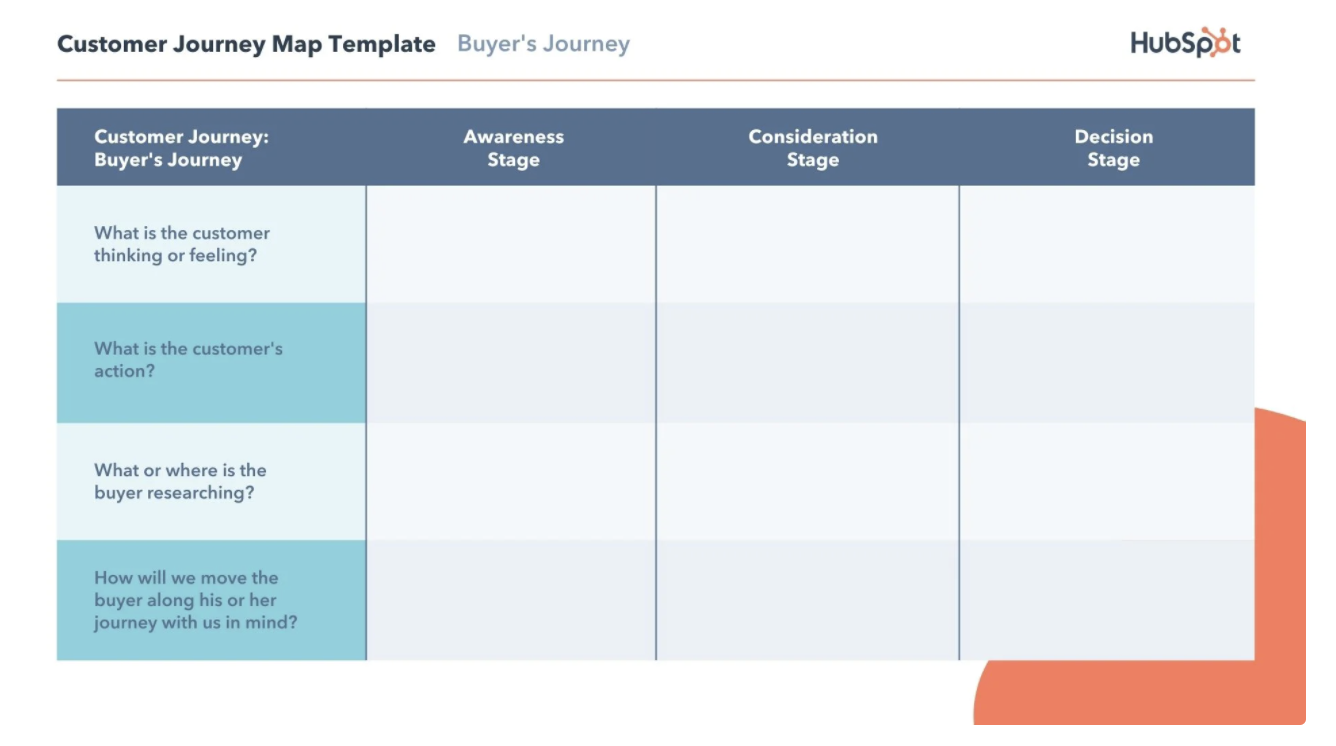
Because this is an example of a journey with a longer sales cycle, it also breaks down the stages into substages to dig further into the mindset of a potential customer.

Under the Awareness Stage would be the Stranger. Under the Consideration Stage would be the Subscriber/Lead and MQL (Marketing Qualified Lead). And under the Decision Stage would be the Opportunity and the Deal Closed/Handoff.
As a customer moves from, say, Subscriber to MQL in the Consideration Stage, they will experience different emotions and require different touchpoints to move through the sales funnel.
For example, a blog subscriber or newsletter subscriber might not even be able to afford your product or service, so it wouldn’t make sense to assign them a sales rep and waste that rep’s time.
However, once a subscriber becomes an MQL, and you know they fit your customer profile you can start treating this person as a real potential customer by dedicating more time and resources.
This also makes for a more relevant experience from your customer’s perspective. No one likes to be hassled to buy a product they can't afford.
In the overall customer journey, the subscriber and the MQL are both still in the Consideration Stage but they should be treated in a different way which is why it’s important to break the journey down into smaller stages if you have a longer sales cycle.
What Makes a Good Customer Journey Map
Above we walked through several interesting examples of customer journey maps and discussed the pros and cons. Now, as you get ready to create your own map, let’s talk about key elements to keep in mind for best practices.
1. It Should Be Based on Market Research Plus Real Customer Data
According to a study from Ascend2 in partnership with Ansira, enterprise marketers are using customer feedback surveys (53%) and customer journey marketing research (47%) to build journey maps.
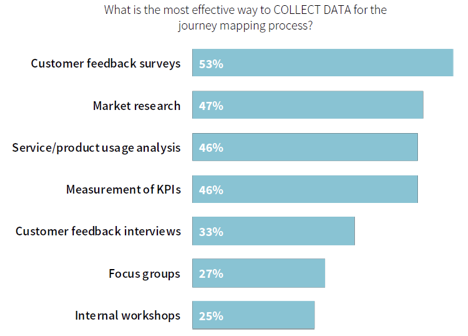
This is a great combination because it includes work based on theory as well as the real-world experiences of shoppers. And having this mix is critical for constructing effective journey maps and ultimately optimizing the customer experience.
Why is this combination key?
Customers don’t always know what they want or what they would prefer if they have never experienced a new product or feature before.
Therefore, it’s up to the business to continuously innovate and present ideas to shoppers. These new products and features should be workshopped based on a customer persona and user research.
Then, once the product or new feature is created, to make it as beneficial to the user as possible, feedback should be collected so improvements can be made.
Because customer journey maps need to take into account the thoughts and actions of users, compiling a document that includes a combination of market research and customer feedback surveys is the best way to get the data you need to make an effective journey map for your ideal buyer persona.
2. It Expands Beyond Your Marketing Funnel
A common pitfall for many companies when customer journey mapping is making a storyboard of the marketing funnel or marketing plan.
The marketing funnel is a good basis for creating a skeleton of the marketing portion of experience maps, but the user journey map should go well beyond marketing.
What does this mean?
The marketing funnel can be broken down into customer journey stages , just like your customer’s journey. It starts with awareness with your target audience and ends with a purchase from your ideal customer persona in the most basic sense (we often like to take this beyond purchase to gaining a loyal customer and getting a repeat purchase).
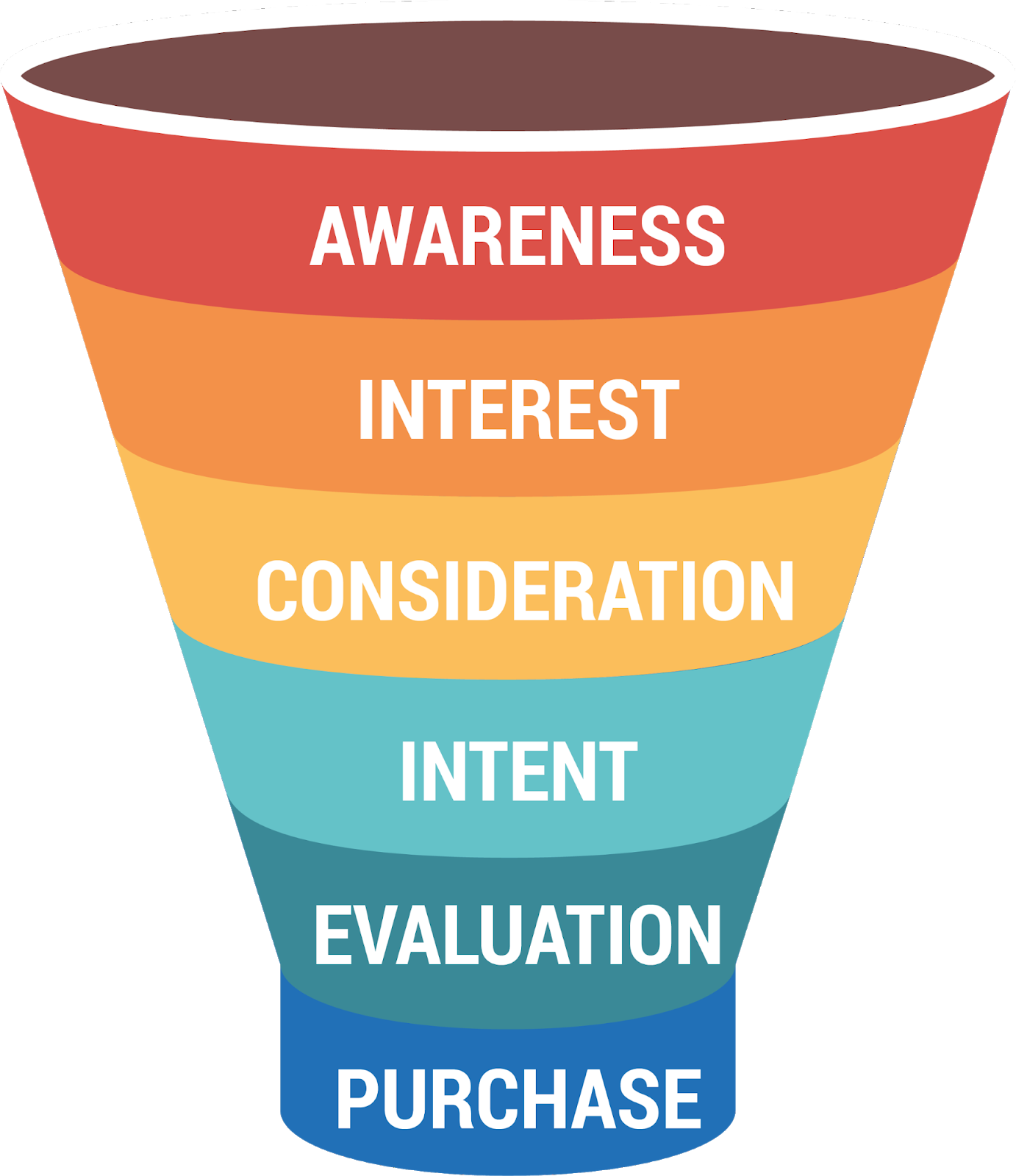
This means in the awareness stage of your marketing funnel you may talk about social media, Google Ads, and other forms of awareness building.
Then in the interest section, you may discuss email marketing, webinars, and other forms of content that increase interest. And in the consideration phase, you may talk about the UX design of your website, sales demonstrations, customer service, and so on.
A good marketing funnel will detail basic activities that should be carried out at each stage of the funnel for your user persona.
The Customer journey maps goes well beyond these basic activities and also lists out what a customer is thinking, feeling, and doing at each stage of the marketing funnel.
Think of it as a marketing funnel on steroids! It’s a much stronger and more powerful document than just your basic marketing funnel or marketing plan.
Additionally, any customer experience mapping needs to go beyond the marketing funnel. It should include the entire user experience with the product or service, each step in the sales cycle, and the touchpoints a person may routinely have with customer service.
3. It Includes KPIs
Good customer journey maps will include the various stages of the sales and marketing cycle as well as the thoughts, feelings, and actions of the user at each stage. Great customer journey maps will include KPIs for each stage.
Including KPIs is important so that the map can be evaluated by each customer touch point and adjusted when necessary.
Also, note that a customer journey map isn’t a document that is set in stone. It should be updated when new information is learned about:
- Customer behavior
- Customer needs
- Customer goals
- Customer expectations
- Customer satisfaction
- Customer support
- Customer service
It should also be evaluated and adjusted if overall sales and marketing goals are not being met.
Because the world is always evolving, so is the entire customer journey.
Whether you’re using a basic platform like Google Analytics or something more advanced like Woopra that’s specifically designed with the customer journey in mind, it should be capable of tracking all essential KPIs.
Get Started Creating Your Customer Journey Map
There's no better time to start laying the foundation for your customer journey mapping process than today.
By creating a visual representation of the buying process, you’ll gain valuable insight into the customer experience and reasons why customers do and don’t buy from you.
Once you’ve identified customer pain points you can make improvements at the necessary customer journey touchpoints, as well as optimize your customer service blueprint to position your business for sales success.
Remember, the whole goal is to put yourself in your customer’s shoes to create the best possible shopping experience for customer retention!
End-to-End Customer Journey Analytics Tool
Acquire and retain more customers with advanced analytics. Woopra is your single source of truth for tracking your customers.
Related Articles
The beginner’s guide to behavioral targeting to increase conversions.

How to get Started with Analytics

From Emails to Customers — Woopra Campaign Tracking
5 actionable methods to engage mobile customers, explore topics.
© Woopra, Inc. 600 California St 11th Floor San Francisco, CA 94108
- Request a demo
- Product Analytics
- Customer Analytics
- Customer Journey Analytics
- Google Analytics F.A.Q.
- Privacy Policy
- Terms of service

- Our Services
- Case Studies

eCommerce Customer Journey Map: How to Create Top Customer Experiences
Mapping ecommerce customer journey: the bright vessel guide to perfect customer experiences.
Throughout two decades, the Internet has reached every side of our lives. And perhaps the most significant change has been in retail, which has had to adjust immensely. Now, each retailer is competing with the entire world’s worth of the same offering. It’s tough to get the attention of visitors, let alone turn them into customers. That’s why, these days, understanding the eCommerce customer journey is so essential.
There are countless websites out there offering roughly the same products as you. It’s difficult to get new visitors to stay and browse around, and it seems impossible to turn them into customers. That’s why understanding your visitors, their profile and what they’re craving, can make or break your eCommerce site.
So, the first question is: how do you stand out? And the answer is: creating an experience that only you can provide.
Sell Feelings and Experiences
Have you ever noticed that some brands don’t seem to sell any particular product, but rather a feeling associated with it? Coca-Cola might be the prime example of this: in each country they operate, their ads adjust to culture and situation. It’s one of the most recognizable brands in the world, and their actual product doesn’t require advertising. So, they sell a sort of Coca-Cola experience.
That’s the kind of thing you should be thinking of when building your retail brand online. Keep in mind:
- Experiences are products. You’re selling much more than an item: it’s one that can lead to a particular lifestyle.
- People share their experiences with products. With social media in our pockets, we’re all perpetually signed in.
- You can be an active participant in the market of experiences. Take advantage of the inspirational wave and create content around it. Be an active participant instead of trying to catch up.
Build a Great Relationship with your Customers
The only way to do that is by providing the best customer journey possible. You can do that by ensuring that the customer has the best experience shopping with you. Some of the factors for this are:
- That you provide the right items.
- That you have enough stock whenever customers look for something.
- That you have someone who can answer customer questions promptly. This goes from a call center to a chat to email: you should provide options.
- That you’ll act responsibly and quickly in case, customers need to return something.
Building an all-encompassing retail business that caters to every step of the eCommerce customer journey is nearly impossible. As a seller, need to be on top of many things and platforms. That’s why the best strategy is to find out who your customers are and how to care for them.
What’s an eCommerce Customer Journey Map?
We define as steps your customers or clients move through to engage with your company. The more your company interacts with customers; the more complicated this diagram can be. This also marks how necessary the map becomes, whether it’s an eCommerce store or brick-and-mortar.
What’s it for?
- Track-specific customer-company interactions.
- Check which sections of the process aren’t going smoothly.
- Create a more satisfying user experience.
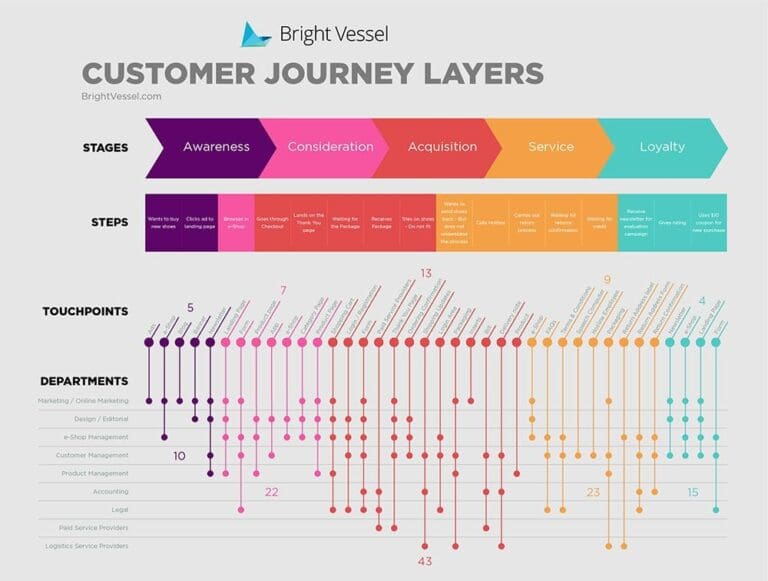
Download an Example of a Customer Journey Here
Or see multiple examples in our post: How to Build a Customer Journey Map with Example PDFs
Sales Funnel
As you may already know, there are three stages to purchase from the customer’s POV.
- Awareness: A person becomes aware of an existing product, and at some point decides to get one.
- Research: They look into different options, weighing in pros and cons.
- Purchase : They buy what appears like the best choice.
- Unboxing: This is a newer step and one most associated with technology. The out-of-the-box experience has become an important part of gadget-buying, and it’s basically a YouTube genre. Tech sellers can tap into those expectations by adding some flair to packaging.

Download an Example of a Marketing Map Here
Where to Channel your Attention
You want to “script” your customers’ experience as much as possible. This way, you’ll lead them towards an experience they’re likely to repeat. You should know what’s happening at each stage of your customer’s timeline. And this knowledge comes from hours of customer research, including observations and even interviews.
Here are a few tips to focus on during the process of finding out how your customers are behaving:
- Actions. What are your customers doing on each stage of purchase? How are they evolving to the next level?
- Motivations. Why are your customers acting the way they are? What’s their thought process and their emotional journey?
- Doubts. Is there anything keeping your customers from moving forward? These can come from uncertainties about the product, over-complicated jargon or any number of things. Perhaps an FAQ or an online chat to answer questions could be in order.
- Problems. Is there anything about your purchase process that’s less than friendly? Are there any barriers keeping your customers from reaching the next stage of the process?
You should schedule a monthly or quarterly meeting to adjust your eCommerce customer journey maps. Regularly, you need to ask yourself how you can be more helpful to your visitors on each step. What can you do to improve your visitors’ experience on your eCommerce site?
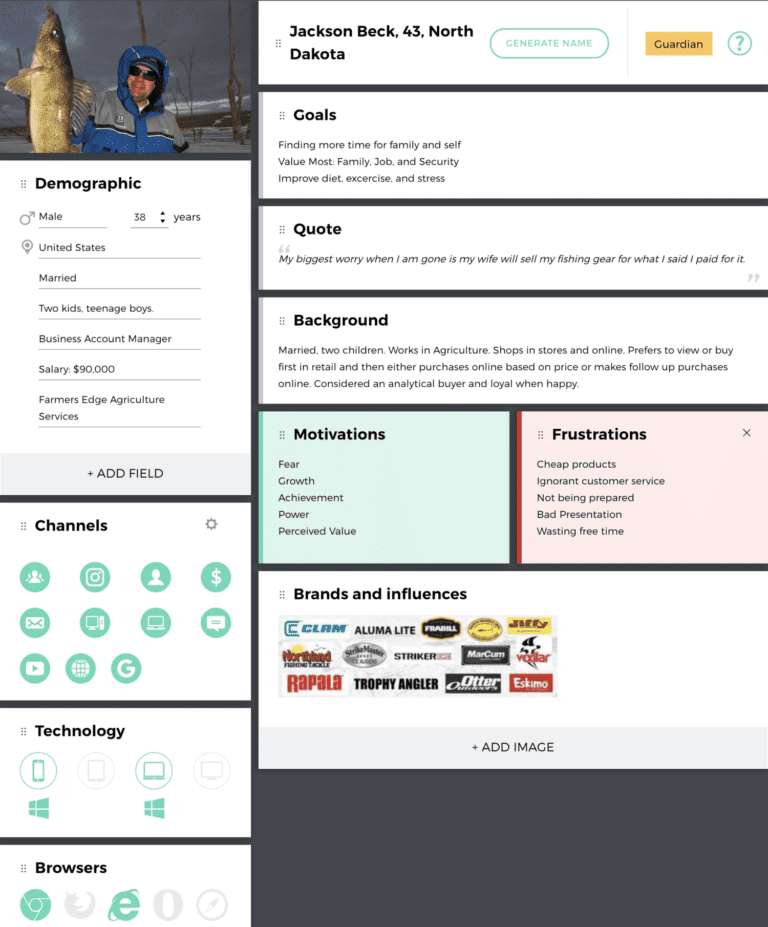
Creating Customer Personas
A customer persona “allows brands to better understand these homogenous groups, and to recognize key traits within them.” They focus on analyzing real customers, thus creating a more in-depth notion of how your customers think. And when you’re building this profile for the first time, it’s best to start small to avoid being overwhelmed.
The path to starting creating your buyer persona begins by interviewing your recent customers and interviewing them. Find who’s recently purchased something on your website and talk to them. What you need to find out here is:
- Why were they interested in the product they purchased?
- How did they find out more about the product? How and where did they research?
- What were the criteria behind choosing this specific product?
- Which competitor sites did they also evaluate?
- Why did they choose you instead of your competitors?
- What would they improve on the overall purchase experience?
Here is a free tool you can use to create your first customer persona. Go here .
This is a great start! The core of creating customer personas lies in the data you have so that you can build your eCommerce customer journey map from there. You can do this by:
1. Monitoring behavior flow
It’s essential to understand the way your visitors move around your eStore. Which pages are they visiting? Where are they clicking? How many of them are buying?
From your Google Analytics Behavior Flow report, you can find trends. Some of them include:
- Drop-off points where many users left the site after going through different pages. What’s happening in that specific point that drives visitors away?
- Page views. What page do visitors go after landing on your homepage?
- Which part of the funnel your customers are in. Are they viewing more blog entries? That can mean they’re finding out more about your product, building awareness!
By using your Behavior Flow report, you’ll get a better understanding of what your visitors do when on your site. Studying each stop can help you find where to focus to motivate visitors to become customers.
2. Analyzing the conversion path
As we’ve mentioned before, it’s of the utmost importance to have a presence in several channels. If you’re a small eCommerce store, you need to get your name and brand out there. It usually takes someone to see your brand or products on different platforms before deciding to become a customer.
Potential customers might find you through Facebook, Twitter or Instagram. They might later bounce back to another social network and look you up there. Then go back and forth on your page before actually making a purchase.
Through the Google Analytics Top Conversion Paths report, you can find out:
- Which path your visitors take. This includes entering your site from different channels.
- Which platforms are your visitors using to get to know your product.
- How visitors reached your site.
If you see that the majority of your influx comes from a specific social network, like Instagram, focus on it. Share content there that builds on your brand, showing what you’re about and the experience you’re selling.
3. Molding your eCommerce customer journey map to your specific needs
Now that you’re aware of who exactly is visiting your website, you need to adapt. What will ultimately set you apart from other similar sellers is your relationship with the customer. You need to understand your customers’ thought process, building a strong relationship with them. You want them to trust you, and find your eCommerce experience a pleasurable one.
With the data on your hands, you can understand why your customers act the way they do. Your job is then to offer just what they desire, from content to products.
Remember that:
- You can’t control when and if they purchase. Your visitors will become customers whenever they’re ready, and not before. You won’t entice them with a particular sale if they’re not there just yet. If you push too hard, you might draw them away.
- You depend on your eCommerce customer journey to know what content to place and where. Only after you see the way visitors act on your website can you test content on different sections. This can pave the way for the kind of content your visitors crave, from storytelling emails versus marketing campaigns.
You can do onsite testing and customization through platforms like Google Optimize or Nosto. Offsite, some apps include Shoelace and Klaviyo.
In Conclusion
What all this boils down to is quite simple: your primary focus should always be in how you relate to your customers. You need to understand who you’re selling to and what exactly do they require from you.
Psychologically understanding where they’re coming from is a big factor towards success. The way you respond to customer needs is a significant factor in whether they’ll remain loyal to your brand. Provide value at each stage of the eCommerce customer journey map, and you’re on your way to greatness! Bright Vessel provides eCommerce solutions for all types of businesses, with custom strategies for your specific industry. Contact us now to find out more!
Recent Posts
- The Growing Impact of B2B E-Commerce in 2024: Key Statistics and Trends
- How to Fix a Social Share Image on Facebook with the Sharing Debugger Tool
- Global B2B Ecommerce GMV: A Deep Dive
- Why WooCommerce is the Best Platform for B2B Businesses
- AIOSEO vs. Yoast SEO - Which One Triumphs for Your WordPress Site?
One comment on “eCommerce Customer Journey Map: How to Create Top Customer Experiences”
Wow Thanks for this information i find it hard to locate really good important info out there when it comes to this material appreciate for the thread website
Leave a Reply
Your email address will not be published. Required fields are marked *
Check out another blog post!

How to Reach More Visitors with WordPress

Email Marketing for Online Stores
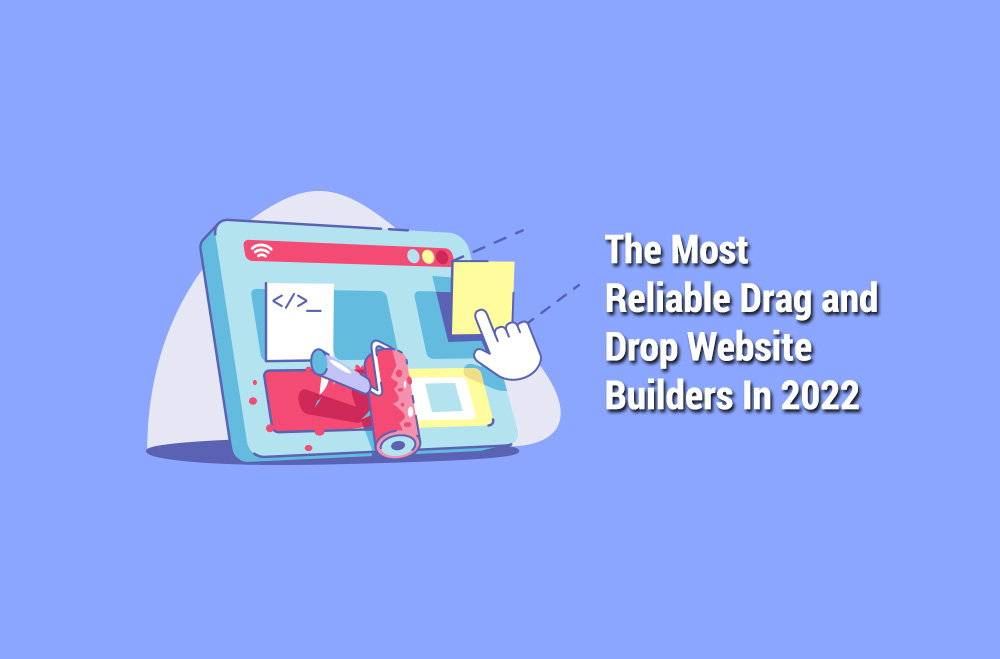
The Most Reliable Drag and Drop Website Builders

What Is Customer Retention?

The ECommerce Funnel for a Successful Online Store

How to Increase Ecommerce Sales 2022
Let’s work together.

Learn More About:
- Customer Acquisition
- Optimization
- Customer Experience
- Data & Analytics

How Ecommerce Brands Can Create a Conversion-Powered Customer Journey Map
A 5 step process to help you build a customer journey map for your ecommerce brand that identifies opportunities to improve conversions.

Do you know your customers well? Are you able to track their journey with your brand from start to finish? If the answer to either of these questions is no, you likely have a major blindspot into your customers’ motivations and needs. And therefore, you probably aren’t providing a great customer experience.
Understanding the route your customers take to purchase means stepping into their shoes and getting to grips with their pain points, objections, and goals. Doing this will ensure you give them all the information they need, exactly when they need it.
Building a strong ecommerce customer experience
The customer’s experience is everything for ecommerce brands . The sheer amount of competition means that if a customer isn’t happy with the service or can’t find what they’re looking for, there are plenty of other places for them to go. On the flip side, if you provide a stellar experience that’s smooth and enjoyable, there’s a good chance customers will come back and become loyal over time.
In fact, a study by XM found:
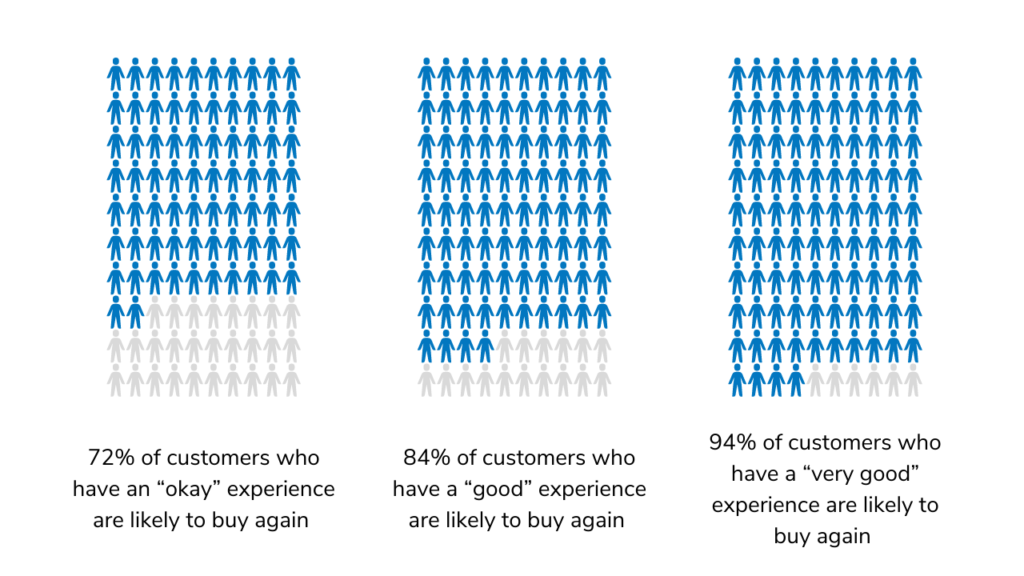
- 72% of customers who have an “okay” experience are likely to buy again
- 84% of customers who have a “good” experience are likely to buy again
- 94% of customers who have a “very good” experience are likely to buy again
Ramping up the customer experience from an “okay” experience to “very good” can improve the chances of customers returning by 22%.
But where do you even start?
Identifying your customers’ key needs and pain points can feel daunting, especially if you don’t have a clear idea about who you’re serving. However, once you start to dig into the different stages of the customer journey, you can determine what customers need at each and every touchpoint.
Enter the customer journey map.
This is a visual representation of how customers move through your website, from the initial discovery of your brand right up until the point of sale and beyond. The benefits of customer journey mapping are self-evident, but it mostly helps identify user experience pain points and craft thoughtful experiences aimed at minimizing customer objections.
Want a 12 minute walk-through of how to create a customer journey map?
What is a customer journey map?
A customer journey map does exactly as it says on the tin: it illustrates the journey a customer might take with your brand. Essentially, it covers each step they take from start to finish, from how they find you to where they end up (whether that’s making a purchase or jumping ship to a competitor).
Having a meaningful customer journey map is the first step in creating a strong conversion rate. The better you understand the journey your customers take, the easier it is to optimize each stage for more engagement and sales.
For example, a simple customer journey map for an ecommerce brand might look something like this:
- Discovers the website via an Instagram ad
- Checks out the product page and reads several reviews
- Buys the product
- Shares their experience with others
- Upgrades the product or replaces the product
This is just a sample journey, and it’s often the case that no two customer journeys are the same (and they’re very rarely linear like this one).
Some customers might skip one stage of the journey completely if they’ve received a solid recommendation from a friend, while others might hang around the research stage for a bit longer, especially if they’re buying a high ticket item.
Don’t confuse the term customer journey with buyer lifecycle, either.
It’s a common mistake ecommerce brands make, but defining the key differences between each one will help you take on a customer-centric mindset .
The customer journey is all about understanding the route to purchase from the customer’s perspective, while the buyer lifecycle is understanding it from the business side. Put simply, the customer journey covers all of the customer-facing experiences that visitors to your ecommerce store will have.
How to make a customer journey map in 5 steps
Creating a customer journey map means stepping into your customers’ shoes and documenting all of the potential touchpoints they might interact with.
To start, it’s a good idea to gather a small group of three or four customer experts in a room. These should be people who understand your customers, what they want, and how they behave. For example, you might get a customer service rep, a marketer, a merchandiser, and a copywriter together, each of whom has a different kind of working knowledge about your customer base.
Their diversity of embedded expertise will be useful in building a complete picture of what users experience, which you can use together with in-depth customer research, metrics, and hard data.
As you’re creating your customer journey map, there are four things that should be at the front of your mind:
- Actions: What actions customers are taking at each stage and how they are moving onto the next stage
- Motivations and emotions: Why the customer is motivated to move onto the next stage and what emotions they’re feeling as they do so
- Questions, doubts, or objections: What questions, doubts, and objections are stopping customers from moving to the next stage
- Barriers: What barriers customers come up against that makes them hesitant to move forward
Now it’s time to get started.
Step 1: Define your character and the situation
At the root of every customer journey map is the customer.
Every brand has a unique relationship with its customers, so it’s important that you understand who you’re dealing with. This involves going deeper than surface-level demographic information and digging into psychographic tendencies and customer behavior.
You don’t need a fully-flushed customer persona to make this work. Instead, it’s about using the information you already know about your customers to outline what a user might go through before, during, and after a purchase.
When defining the character whose journey you will map in this exercise think about someone who paints a clear picture for you. Here are two examples:
- Katy: A working mom setting up her home gym
- Dean: A recent college graduate purchasing their first new car
Once you’ve landed on your character, you should be able to describe them in one sentence, but give them life with a few persona-like details. “Katy is a working mom. Her kids leave for school at 8 am and she has only a half-hour before she starts work. She’s motivated to make the most of that time by creating an efficient home gym.”
Crafting a character and a situation that your team can clearly envision will make it easy for the experts in the room to map a life-like customer journey in the steps to come.
Enjoying this article?
Subscribe to our newsletter, Good Question, to get insights like this sent straight to your inbox every week.
Step 2: Define the different stages of the customer journey
The common stages involved in the customer journey are awareness, consideration, and decision. Each stage demands different information for customers and requires a unique set of touchpoints in order to drive conversions.
- Awareness: customers are just becoming aware that they have a problem that needs solving and are educating themselves on potential solutions
- Consideration: customers know what solution they need and begin to research their options
- Decision: customers settle on a product or service and make a purchase
Say, for example, a customer is looking for a new eco-friendly water bottle:
- Awareness: they might have been using plastic bottles for a while and have read up about why they should change them for reusable bottles.
- Consideration: once they’ve decided they need to buy an eco-friendly water bottle, they might start researching which ones are available (the answer: a lot) and spend some time trawling through product pages and comparing brands.
- Decision: at some point, there will be a clear winner, whether it’s because the bottle looks how they want it to look, uses the right materials, has great reviews, or is in their budget, and they will go ahead and buy it.
There is also a post-purchase stage of the customer journey where customers turn into loyal, repeat buyers.
Take the eco-friendly water bottle example again. While shoppers may not repeat the purchase for themselves, they might be interested in a gift for a friend or a complimentary reusable utensil step.
Step 3: Define the steps in each stage
The aim is to move customers seamlessly from one stage to the next. At this point, you’ll need to know what customers need from you at each of these stages. It helps to have your customer research to hand here to identify the major pain points and objections buyers might have.
Let’s use the eco-friendly water bottle example again and plot out the potential user goals for the customer journey:
- Awareness: notice my recycling is always full and hear the media say that microplastics are bad, and that recycling doesn’t work
- Consideration: start thinking about how I can reduce plastic waste and look up search terms associated with this, like “best reusable bottle”
- Decision: choose the company that aligns with my values and that I feel the most drawn to
When you know the steps for each stage, you can then assign customer touchpoints that tie into these steps and help push customers through the journey.
Step 4: Identify (and implement) touchpoints at each stage
The steps provide the backbone of your customer journey, and now it’s time to incorporate touchpoints that align with these steps. These touchpoints are where your customers might be interacting with content related to their purchase, such as ads, search engines, or via word-of-mouth.
This might look something like this:
- Awareness: blog posts, social media copy, and ads educating customers on the pros of eco-friendly bottles and a CTA to drive them to your site
- Consideration: testimonials, reviews, detailed product descriptions, and instant customer support to pitch your water bottle as the best and tackle any objections
- Decision: videos of your water bottle in action, more reviews, and an easy checkout system
Touchpoints can come in many shapes and sizes and refer to any moment a customer has contact with your brand (these are often dubbed “moments of truth”). Just remember that they should align with the goals you want to achieve at each stage. Keeping in mind all the places your customers might hear about or engage with your brand or product will help you create a more holistic ecosystem and uncover blind spots in your marketing strategies .
They might include:
- Online ads and social media campaigns
- Offline advertising methods
- Blog posts, ebooks, and on-site content
- Case studies
- Infographics and other visual media
- Social media posts
- Email marketing messages
- Customer support
- Order confirmation
- Packaging and delivery
Don’t forget about the post-purchase touchpoints too, as the stronger these are the more likely a customer is to come back and buy from you again.
Step 5: Tap into user thoughts and tackle any objections
Not every customer is going to make it all the way through the journey to purchase.
Some might choose a competitor, or others might change their mind at the last minute. Whatever the timing, it helps to know why customers are likely to drop out of the journey so you can bolster the touchpoints and address pain points in those stages.
Ask yourself what your customer might be feeling throughout the journey. Identify objections to better understand why they might be hesitant to convert. Then attach sentiment to each stage of the journey so you can pinpoint parts of the customer experience where emotions are extremely high or low.
At the high points, consider taking advantage of that momentum to add a personal touch, a special reward, an exclusive offer, or a request for a review/referral.
At the low points, consider ways that you might be able to improve customer sentiment through site design, proactive messaging, reassurances/social proof, etc.
Customer journey map examples from winning ecommerce brands
Customer journey maps will look different for every company. The examples we’ve got here are pretty thorough and come from well-resourced companies. Yours doesn’t have to be this detailed straight out of the gate! The first version for many companies (particularly small ones) will often fit on the back of a sheet of paper or a whiteboard but will get more detailed over time as you learn more about your customers through ongoing research.
Amazon is the biggest ecommerce brand in the world and, as such, it has an incredibly complicated customer journey map.
Customers might find the brand in a variety of ways, from ads, links in blog posts, referrals, or simply by visiting direct, and the consideration stage involves a lot more research since there are so many options.
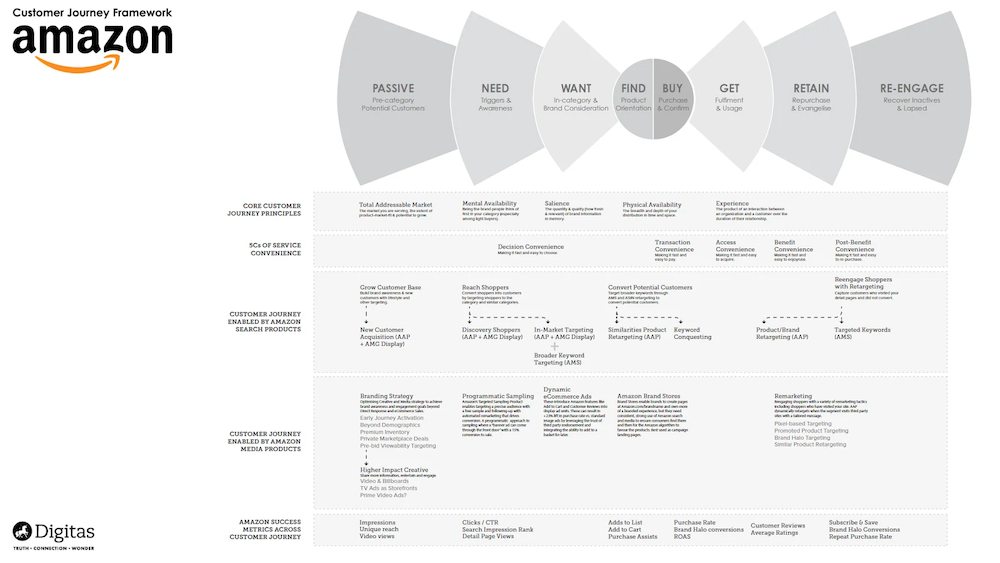
Amazon bolsters the experience and keeps customers moving forward by adding touchpoints such as:
- Personalized product recommendations
- Reviews
- Shopping guides
- One-click to buy
- Comparison charts
- Detailed product descriptions
- Paid ads
Lancome’s customer journey map highlights customers’ needs at each stage of the journey. The brand defines the different stages as “on my way”, “getting Lancome”, and “share experience”, with key worries, objections, and questions mapped out for each of these stages.
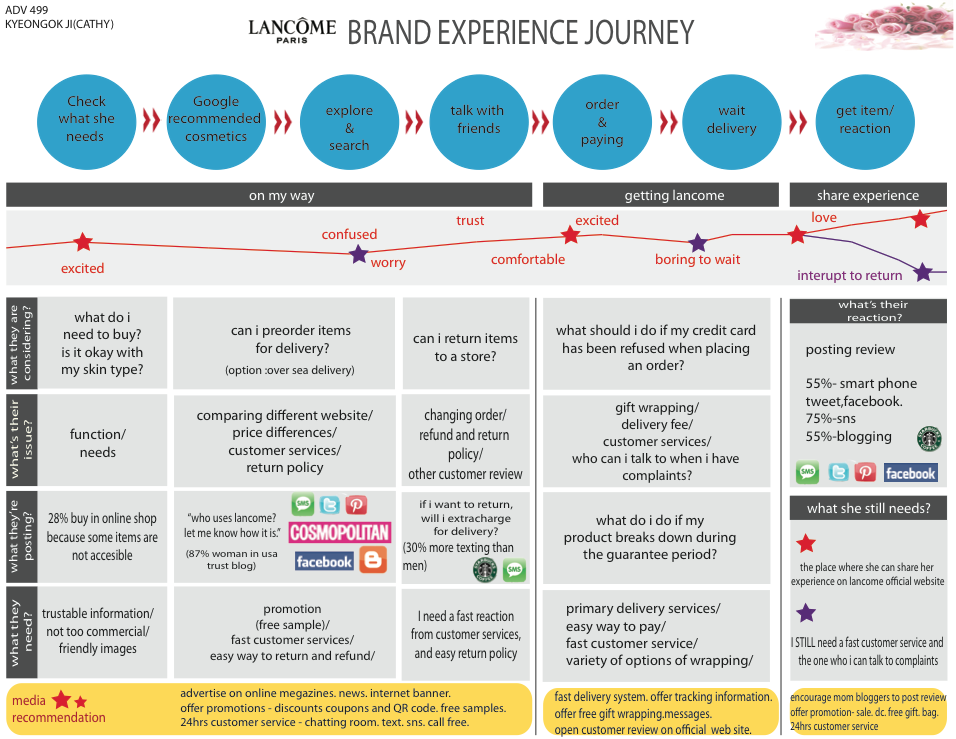
For each stage, there are media recommendations that act as touchpoints, including discounts and coupons, free samples, customer reviews, and influencer marketing campaigns.
Electronics provider Samsung has multiple touchpoints on its website, each of which loosely fall into the three stages of the customer journey:
- Awareness: blog posts and content as part of the #DoWhatYouCant campaign to inspire potential buyers
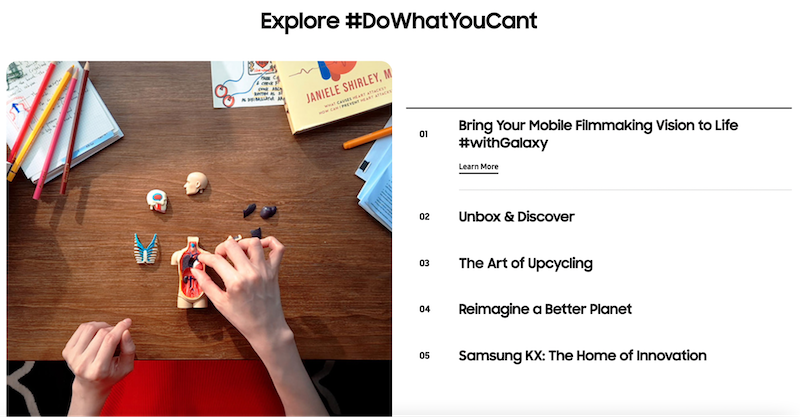
- Consideration: helpful product pages that include comparison lists, high-quality photos, videos, reviews, and a pop-up live customer support channel
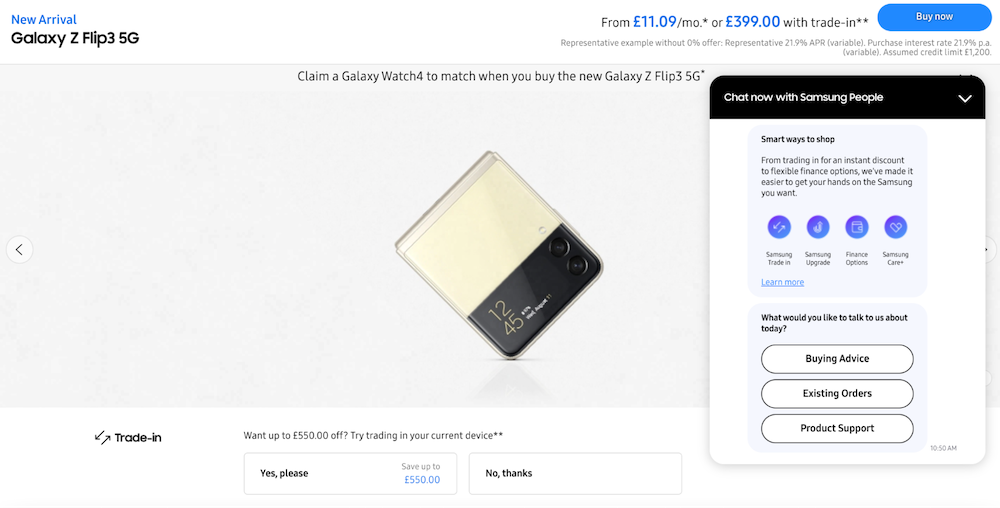
They also have a pop-up offer for customers that look like they’re about to leave the site.

- Decision: an easy checkout process with additional upsells and cross-sells to increase customer retention and cement customer loyalty
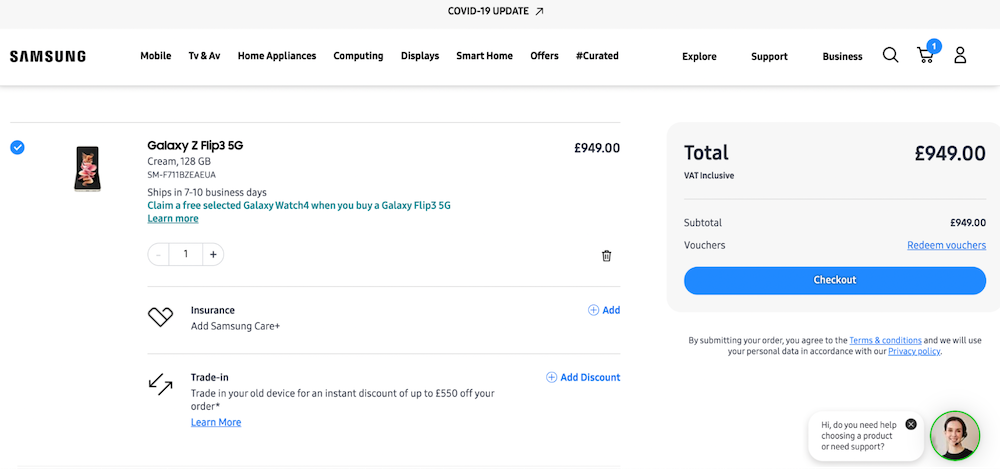
A strong customer journey map is the beginning of a strong conversion rate
Your customer journey map is the backbone of the customer experience.
It drives buyers from one stage to the next by understanding their unique pain points and offering content that tackles any objections. As a result, customers will glide seamlessly through the process, hitting each relevant touchpoint and getting the exact information they need, exactly when they need it.
It’s a no-brainer that a strong customer journey map leads to a stronger conversion rate. When you have a strong map, less customers drop out of the journey, and more make it all the way to the point of sale.
Subscribe to our weekly insights for more customer experience content.
About the Author
Natalie thomas.
Natalie Thomas is the Director of CRO & UX Strategy at The Good. She works alongside ecommerce and lead generation brands every day to produce sustainable, long term growth strategies.

IMAGES
VIDEO
COMMENTS
Make your maps as useful as possible by taking relevant information from a wide range of sources. 1. Website journey data. Google Analytics (GA) is an essential part of your ecommerce website analysis toolkit. Its reports and dashboards give you a high-level overview of how people use and move through your site.
Decision. Retention. 1. Awareness. The first stage of the ecommerce customer journey is awareness. During this stage, a potential customer is experiencing a problem and is researching to understand their problem. They see if it has solutions, overcome misconceptions, and prioritize solutions. 2. Consideration.
An ecommerce customer journey map is a diagram that details how customers engage with your company across various mediums including online, retail, and contact with your customer support team. ... Example customer journey map showing the buyer's time frame, brand's goal, channels, and pages visited at each stage.
An example of a customer journey map for an online grocery store. Notice the level of detail and how stages tie in with KPIs typically associated with the buyer lifecycle or sales funnel. Customer journey mapping is the process by which businesses step into their customers' shoes and chart all the possible experiences they might have.
Take a look at this buyer persona that we created for an e-commerce customer journey map example in our persona building tool: Collect the data. Research is an essential step that comes before analyzing the customer journey of an online store. Adding real-world data brings tangibility to your journey maps and helps you identify the most ...
3. Ecommerce Customer Journey Map Example. This fictitious customer journey map is a clear example of a day-in-the-life map. Rather than just focusing on the actions and emotions involved in the customer's interaction with the company, this map outlines all the actions and emotions the customer experiences on a typical day. Image Source
The future state customer journey mapping template: A day-in-the-life customer journey map template: An empathy map template: A customer journey map example. It can be helpful to see customer journey mapping examples. To give you some perspective on what these look like executed, we've created a customer journey mapping example of the current ...
5. Map the journey with Post-its and pens before digitizing it and sharing it across the company. 2. Rail Europe's B2C journey map. Rail Europe's customer journey map includes interactions before, during, and after a trip. B2C ecommerce travel provider Rail Europe gives customers an easy way to book rail tickets online.
An ecommerce customer journey map is a visualization of all the potential experiences a customer may have with your organization. Such a map also highlights the sequences those experiences are most likely to occur in. It can allow you as a business to identify strengths and weaknesses, and thus make improvements where needed.
The ecommerce customer journey is the complete end-to-end experience of a customer from the initial interaction with a brand's online store to the final purchase. This includes browsing, product selection, checkout, and post-purchase support. Understanding and optimizing the ecommerce customer journey helps businesses enhance engagement and ...
5 stages of the eCommerce customer journey. Your customers' overall journey can be broken down into five key stages. 01. Awareness. Your customer stumbles across your brand for the first time. Be it through an ad, social media, word of mouth, or SEO-they are now aware of your products.
What stands out about this journey map template is that it has a space for describing the specific stage of the customer, which you can also use to write associated actions. There's also a star rating row that can help sum up the customer experience at each stage. 6. Business Software Customer Journey Map Template.
March 4, 2021. Customer journey mapping in e-commerce is a diagram that illustrates the steps your customers go through in engaging with your online business. It starts when they first become aware of your products, to completing a purchase. It can extend to after-purchase care. Buying and selling products on the internet is as popular as ever.
Step 1: Define customer personas. Step 2: Analyze relevant data. Step 3: Identify key touch-points. Step 4: Create an e-commerce customer journey map. Step 5: Using an e-commerce customer journey map. Conclusion.
Here's an example of a customer journey map that shows the touchpoints for each stage: As you can see, in the awareness stage, the touchpoints are from social media. While for the consideration stage, there are inquiries via email and phone calls. ... Start an eCommerce customer journey map to create a seamless experience! To achieve your goals ...
This customer journey map is great because it allows the team to see each customer pain point experienced and, therefore, address these pain points to make the customer experience smoother and more satisfactory. Ecommerce Customer Journey Map Examples. The Ecommerce space is highly competitive in almost every niche these days.
Take the extra time for e-commerce customer journey mapping to build a highly detailed customer profile. For example, an ecommerce store selling cosmetics might have the following ideal customer: Jessica is a 30-year-old female professional in New York City and is passionate about fashion and beauty. She values quality and always looks for new ...
Download an Example of a Customer Journey Here. Or see multiple examples in our post: How to Build a Customer Journey Map with Example PDFs. Sales Funnel. As you may already know, there are three stages to purchase from the customer's POV. Awareness: A person becomes aware of an existing product, and at some point decides to get one.
To build an ecommerce customer journey map, start with four regions: Before the purchase, During the purchase, After the purchase, Reengagement. Create these regions on a spreadsheet or a specialized tool such as Figma. Under each region, add the stages a shopper might go through. Four regions of a customer journey map are common for ecommerce ...
Start small and prioritize the most critical customer personas for your business. The real key, however, is using your existing data to map the ecommerce customer journey based on psychological principles to drive more sales. 1. Monitor how customers interact with your ecommerce business.
Having a meaningful customer journey map is the first step in creating a strong conversion rate. The better you understand the journey your customers take, the easier it is to optimize each stage for more engagement and sales. For example, a simple customer journey map for an ecommerce brand might look something like this:
Example 3: E-commerce - Amazon. Amazon, a global e-commerce giant, employs sophisticated technology and custom systems to guide customers through the sales journey. ... This customer journey map example from Zendesk uniquely emphasizes customer churn and reconsideration. While it doesn't delve into the specifics of customer activities, thoughts ...